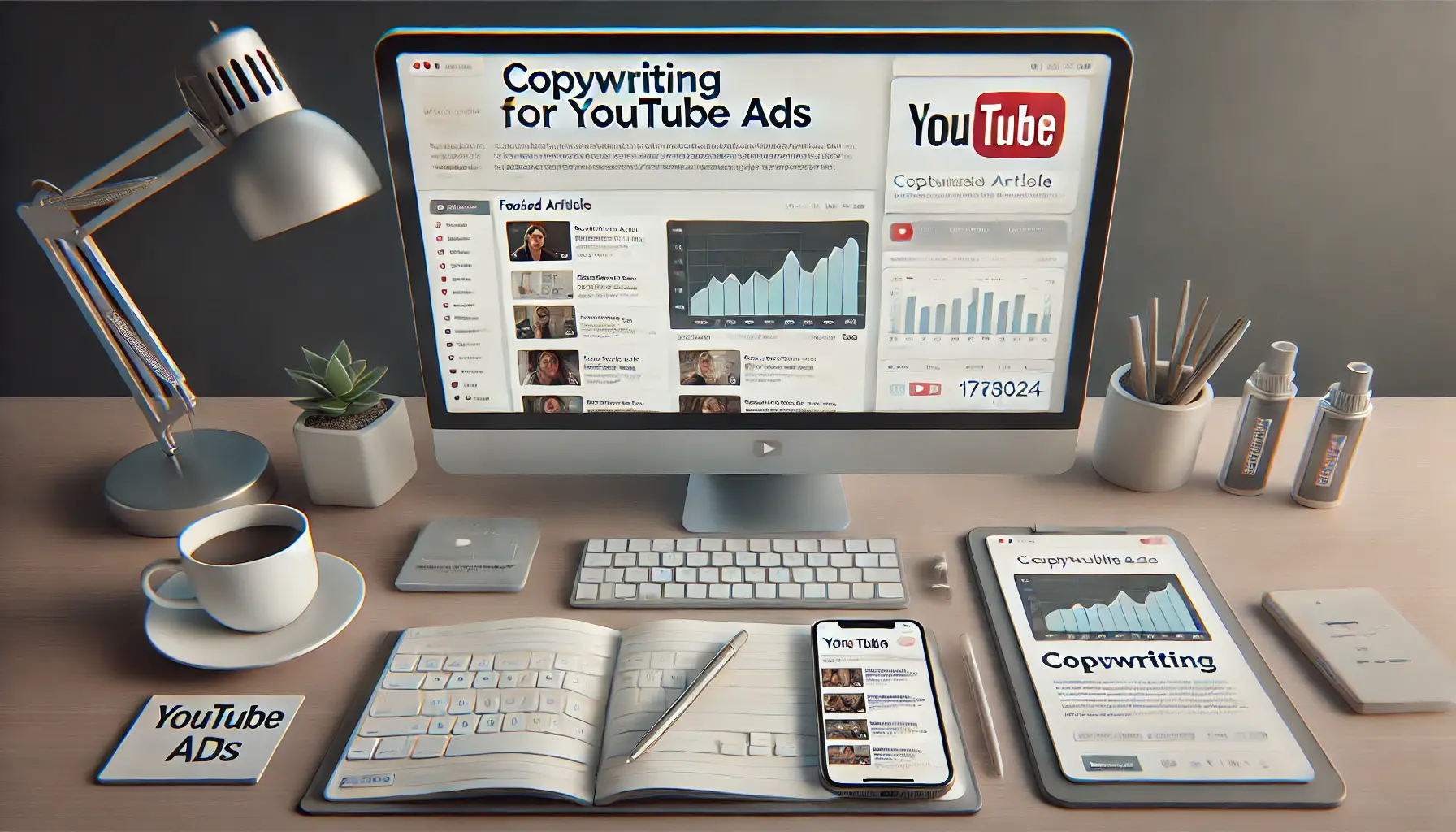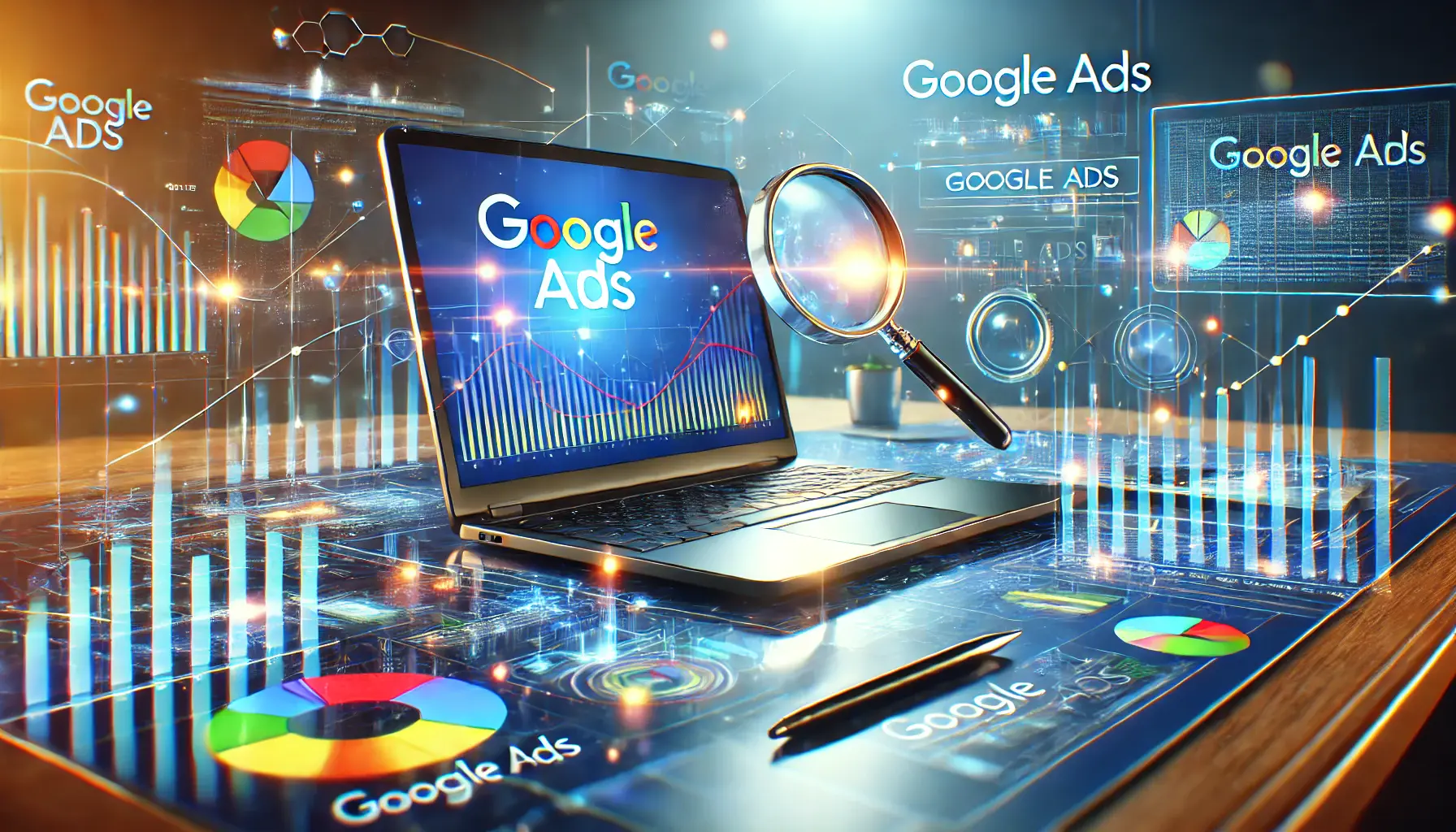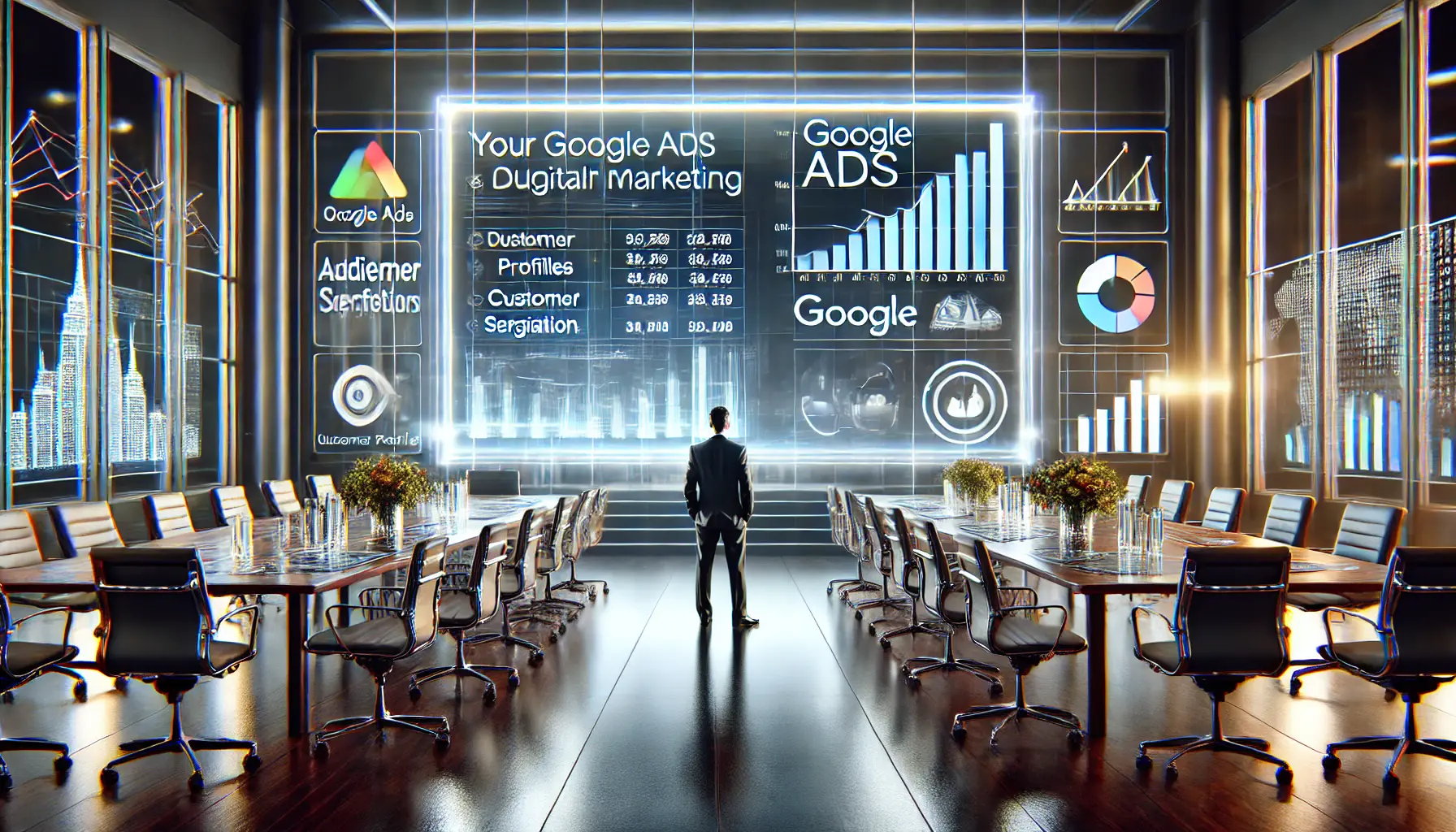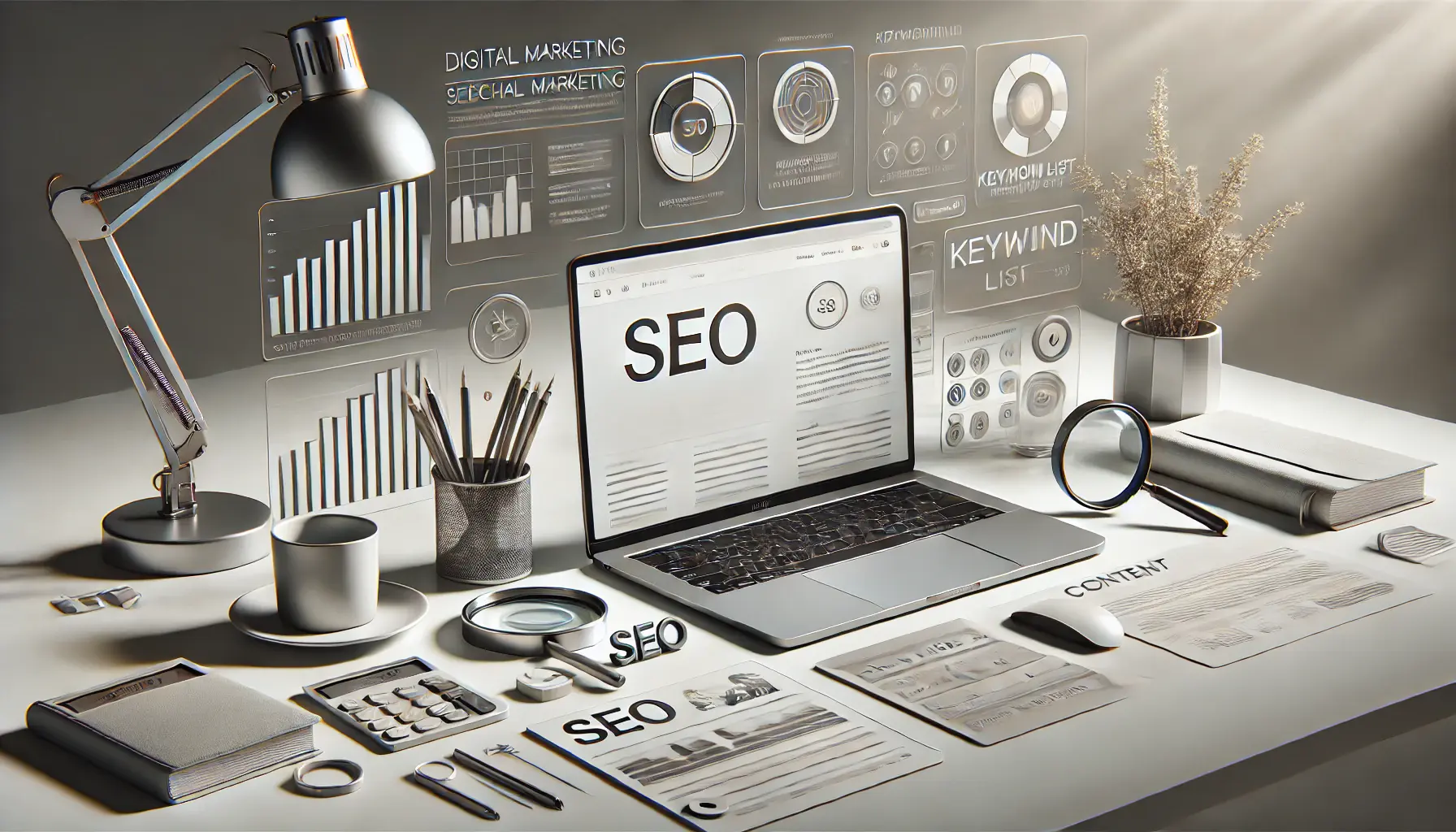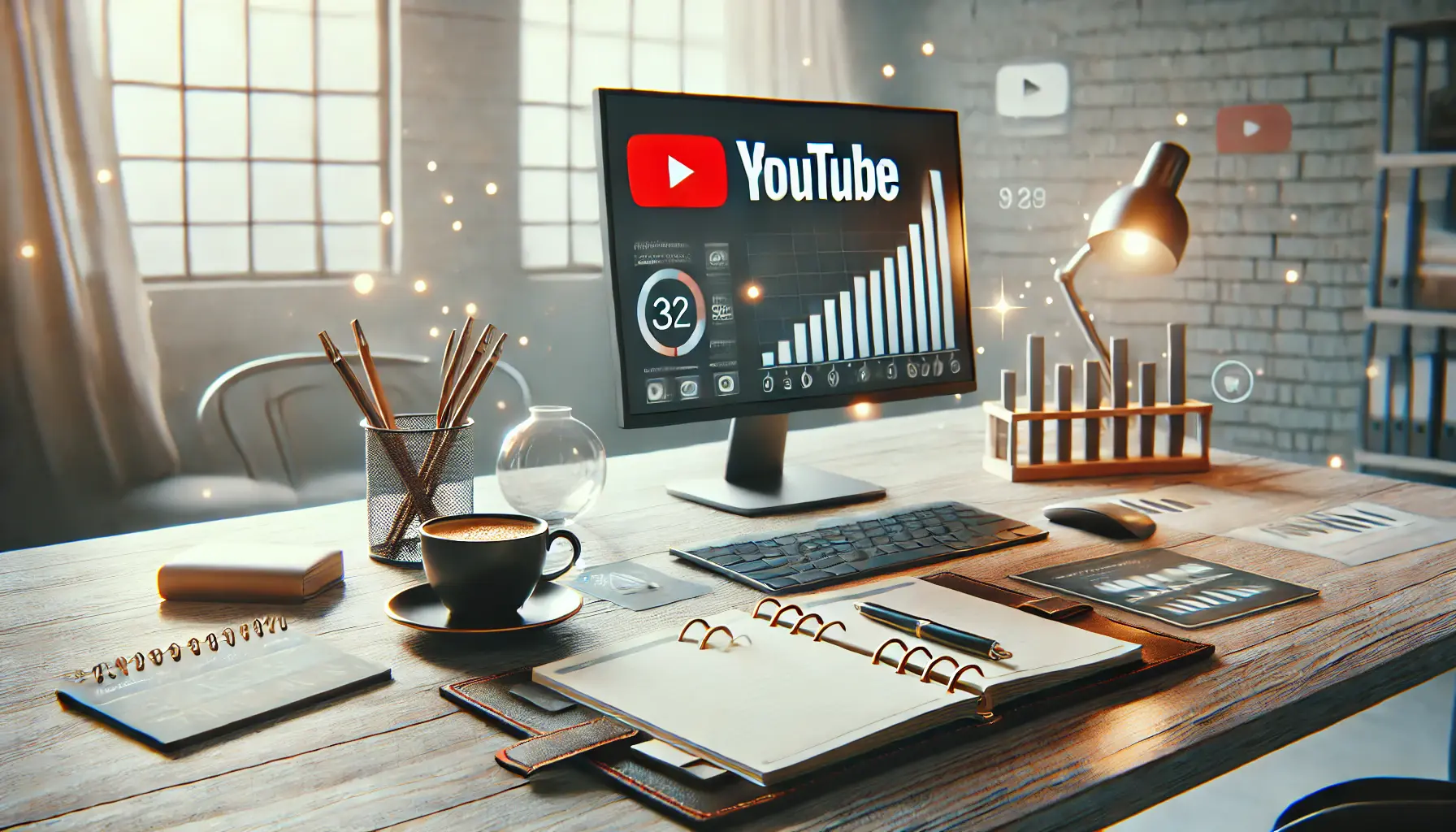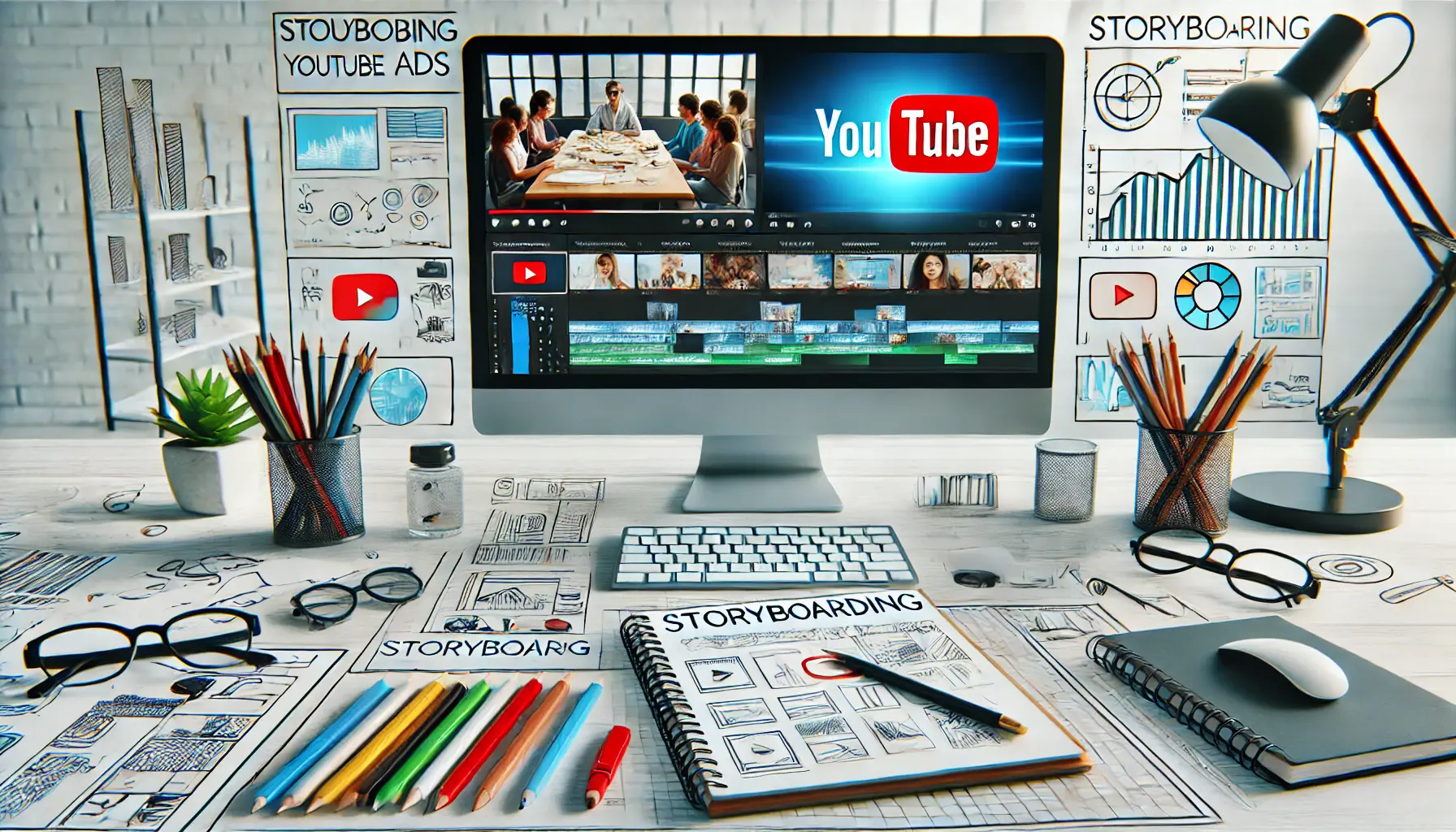Advertising on YouTube is among the most powerful means for any business to connect with its target audienceThe specific group of people an ad is aimed at, often defined by demographics, interests, or behavior. in this digital world.
It’s no surprise to see marketers flocking to it, considering that millions of active users watch videos on YouTube each day.
However, the secret to creating a successful YouTube ad lies not just in choosing the right visuals or targeting options.
It’s also about crafting engaging ad copy that resonates with viewers, captures their attention, and stirs them into action.
In this article, we’re going to look at seven essential tips for YouTube ad copywriting success.
Whether you’re just starting out with YouTube Ads or looking for better results, these insights will empower you to make your ad content more effective, engaging, and impactful.
- Understanding the Basics of YouTube Ad Copywriting
- Writing Attention-Grabbing Headlines for YouTube Ads
- Writing Ad Descriptions for Maximum Persuasion
- Optimizing Copy for Various YouTube Ad Formats
- Testing and Optimizing Your YouTube Ad Copy
- Mastering YouTube Ad Copywriting for Success
- FAQs on Writing YouTube Ad Copies
Understanding the Basics of YouTube Ad Copywriting
Let’s first get a feel for the basics of YouTube ad copywriting.
The art of writing copy for YouTube ads is unique, as there needs to be a balance between clarity and creativity, all while capturing viewer attention in split seconds.
Unlike traditional ads where text might play a secondary role, YouTube ad copy needs to be direct and engaging.
This is because a viewer can skip your ad after a few seconds, so you need to ensure your message comes across quickly and clearly.
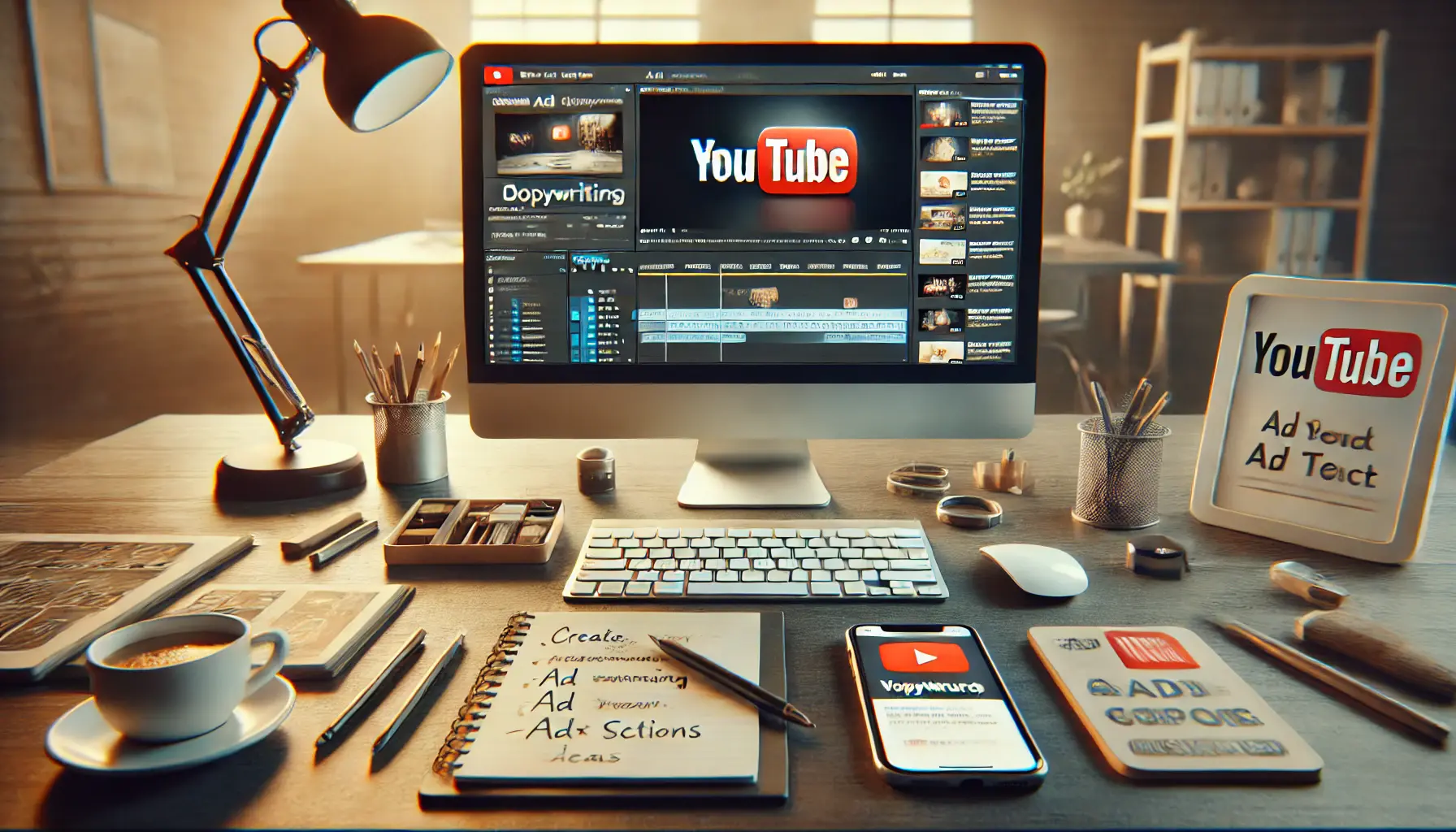
Professional workspace setup for YouTube ad copywriting.
What is YouTube Ad Copywriting?
YouTube ad copywriting refers to the art of writing enticing text that accompanies your video ads on YouTube.
This text could include headlines, descriptions, and call-to-actionA prompt in marketing content that encourages the audience to take a specific action, like clicking a link or making a purchase. statements, directing the viewer on what to do next.
When it comes to ad copy for YouTube, the goal is always the same: engaging your audience, piquing their interest, and prompting action—whether that’s visiting a website, subscribing, or making a purchase.
Great copy bridges your video content and the viewer, providing context, clarity, and compelling motivation.
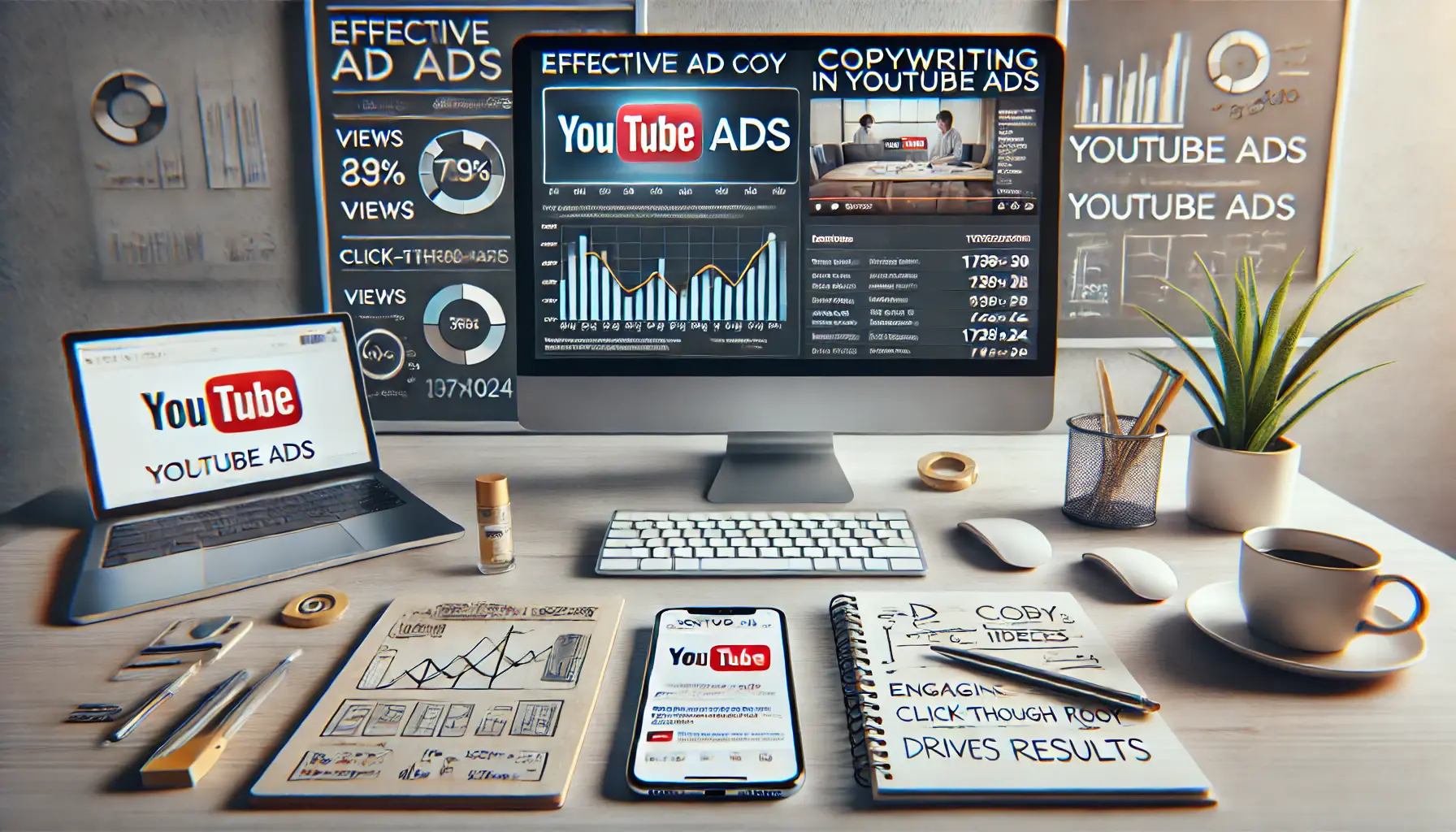
Workspace emphasizing the significance of effective copywriting in YouTube ad performance.
Why Effective Copywriting Matters in YouTube Ads
Good copy can make or break your YouTube ad campaign.
Not only does good copy capture attention, but it also communicates your brand message in a way that resonates with viewers.
Choosing the right words can evoke emotions, spark curiosity, or address the viewer’s pain points, making the ad more memorable.
When viewers relate to your message, they’re more likely to stay engaged and take the action you want them to perform.
- Increases engagement: Relevant and personal copy makes the ad feel more relevant and personal, which increases viewer engagement.
- Develops brand connection: If your ad copy reflects your brand’s values and voice, it helps your audience develop a relationship of trust and connection with you.
- Drives action: Clear and persuasive copy makes it evident what action viewers should take next, whether it’s visiting your site, downloading an app, or subscribing.
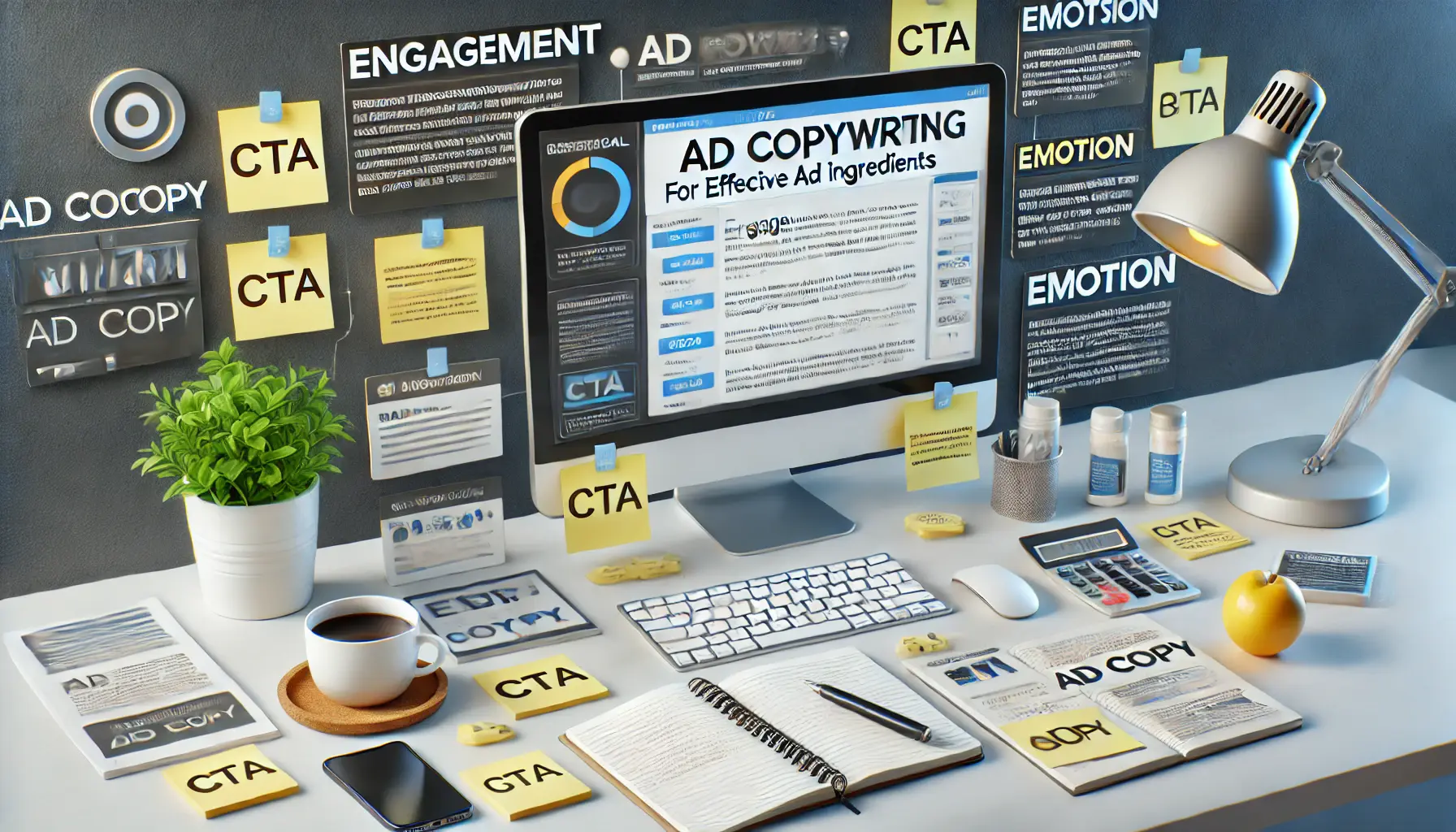
Creative workspace highlighting essential ingredients for good ad copy.
Key Ingredients of Good Ad Copy
Writing effective ad copy for YouTube commercials involves integrating key elements that work together to convey the right message.
Understanding and applying these elements can significantly improve the efficiency of your ad campaigns.
- Sharp, clear, and concise messaging: Use direct, simple language. You have only a few seconds to capture attention, so make every word count.
- Strong call-to-action (CTA): Tell viewers what to do next. Whether it’s ‘Learn More,’ ‘Sign Up,’ or ‘Shop Now,’ a clear CTA will prompt action.
- Emotional appeal: Words that elicit emotions, such as excitement, curiosity, or urgency, can drive engagement and conversion.
- Consistency with brand voice: Ensure your ad copy aligns with your brand’s voice and values to build authenticity and trust.
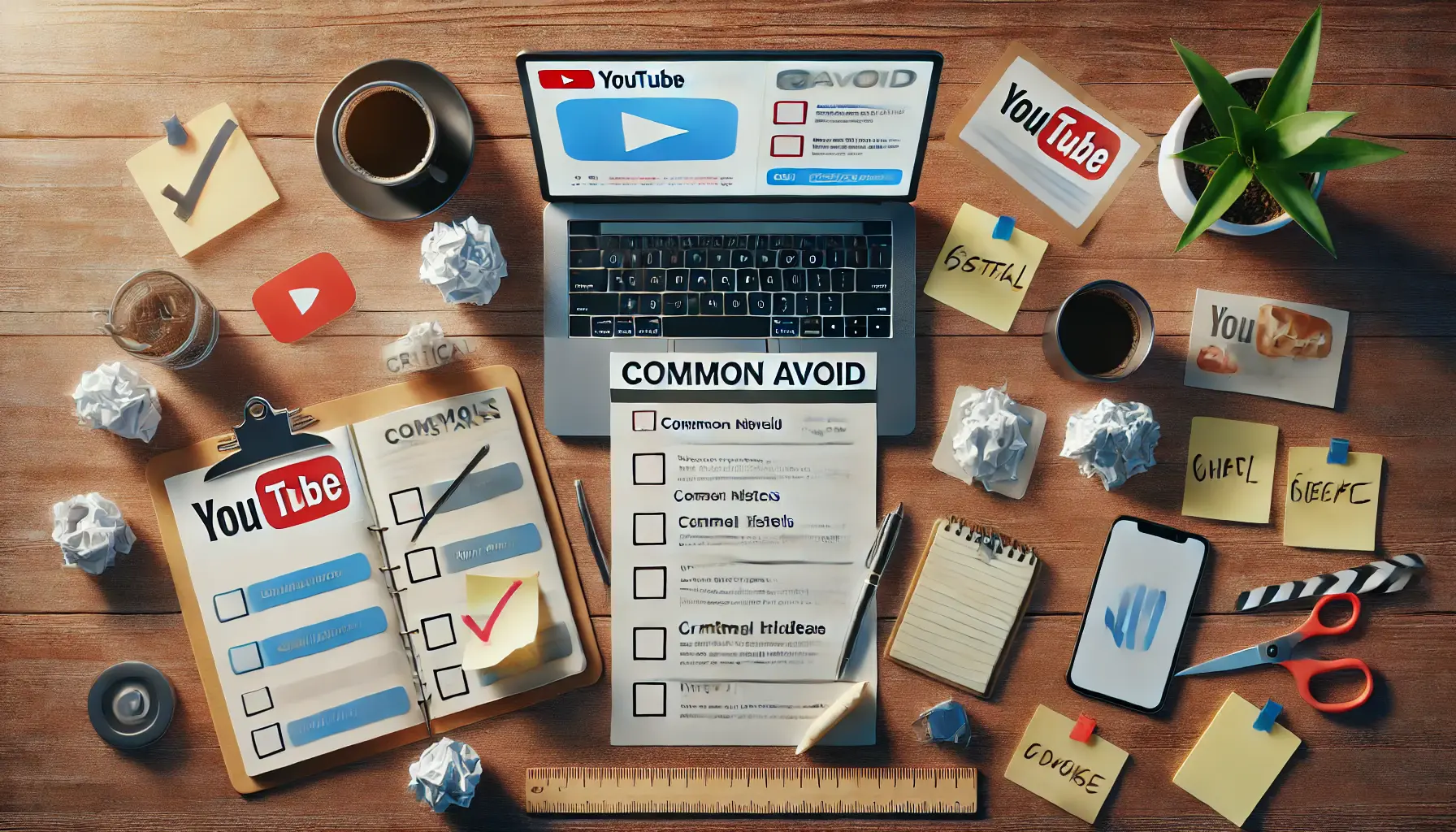
Workspace illustrating common pitfalls in YouTube ad copywriting.
Common Mistakes to Avoid in YouTube Ad Copy
Even experienced marketers sometimes make mistakes in YouTube ad copywriting.
Being aware of these common pitfalls can help you create stronger, more effective ads.
- Overloading with information: Keep it simple. Too much information can overwhelm viewers and lead to confusion or disengagement.
- Ignoring the viewer’s perspective: Focus on what matters to the viewer, not just what you want to promote.
- Weak or unclear CTA: Without a strong call-to-action, viewers might watch your ad but won’t know what to do next.
- Using overly complex language: Simple, straightforward language is more effective for getting your message across.
Grasping the fundamentals of YouTube ad copywriting helps in crafting messages that quickly capture viewer interest and encourage engagement.
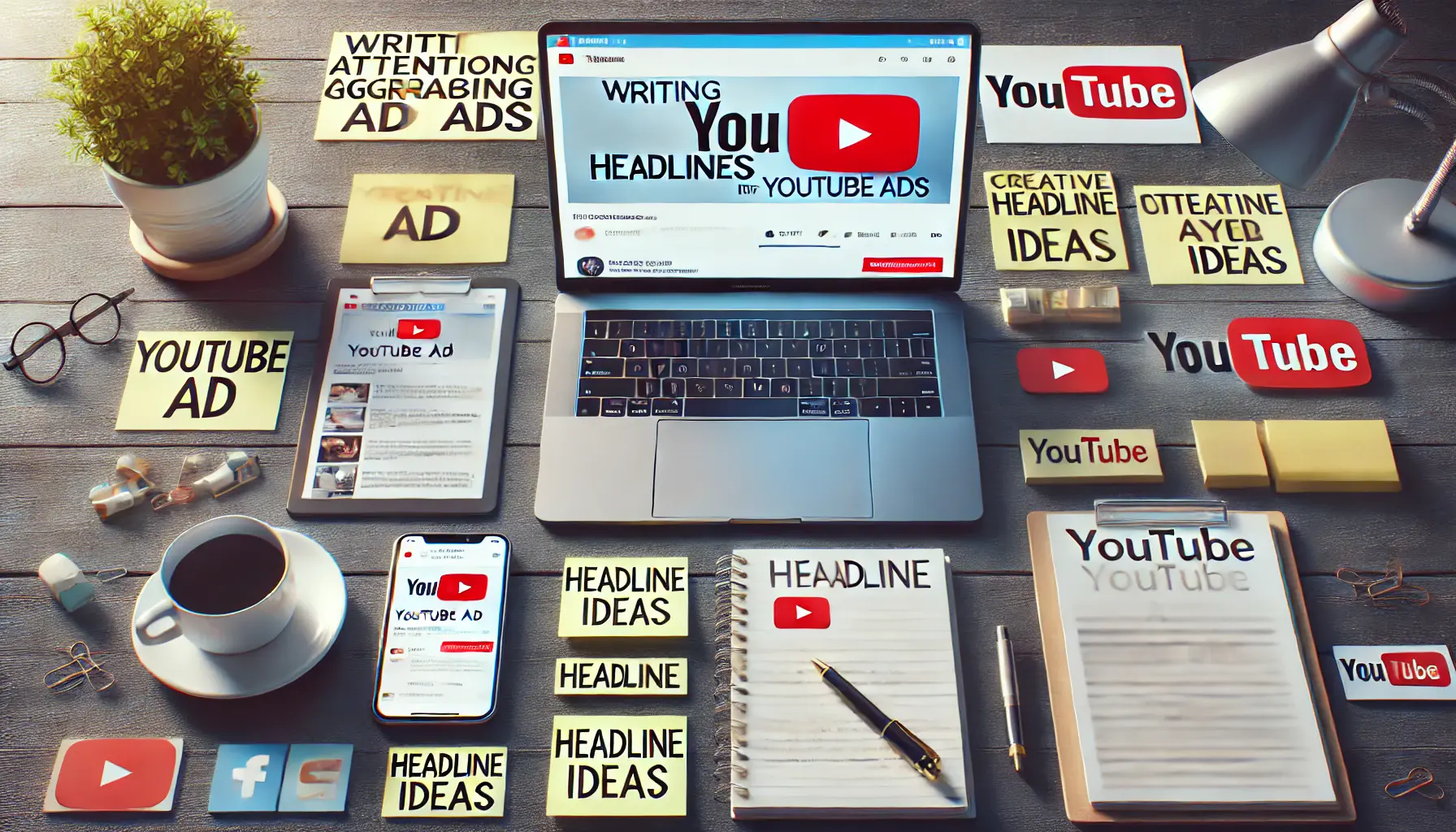
Workspace setup for crafting attention-grabbing YouTube ad headlines.
Writing Attention-Grabbing Headlines for YouTube Ads
One of the most important aspects of successful YouTube ad copywriting is crafting headlines that immediately seize viewers’ attention.
A great headline can make all the difference between viewers engaging with your ad or skipping it within seconds.
The headline sets the tone for your ad, so it’s crucial to create one that speaks directly to your audience’s needs, interests, or emotions.
Your goal is to impress within a second and invite viewers to explore the rest of your ad.
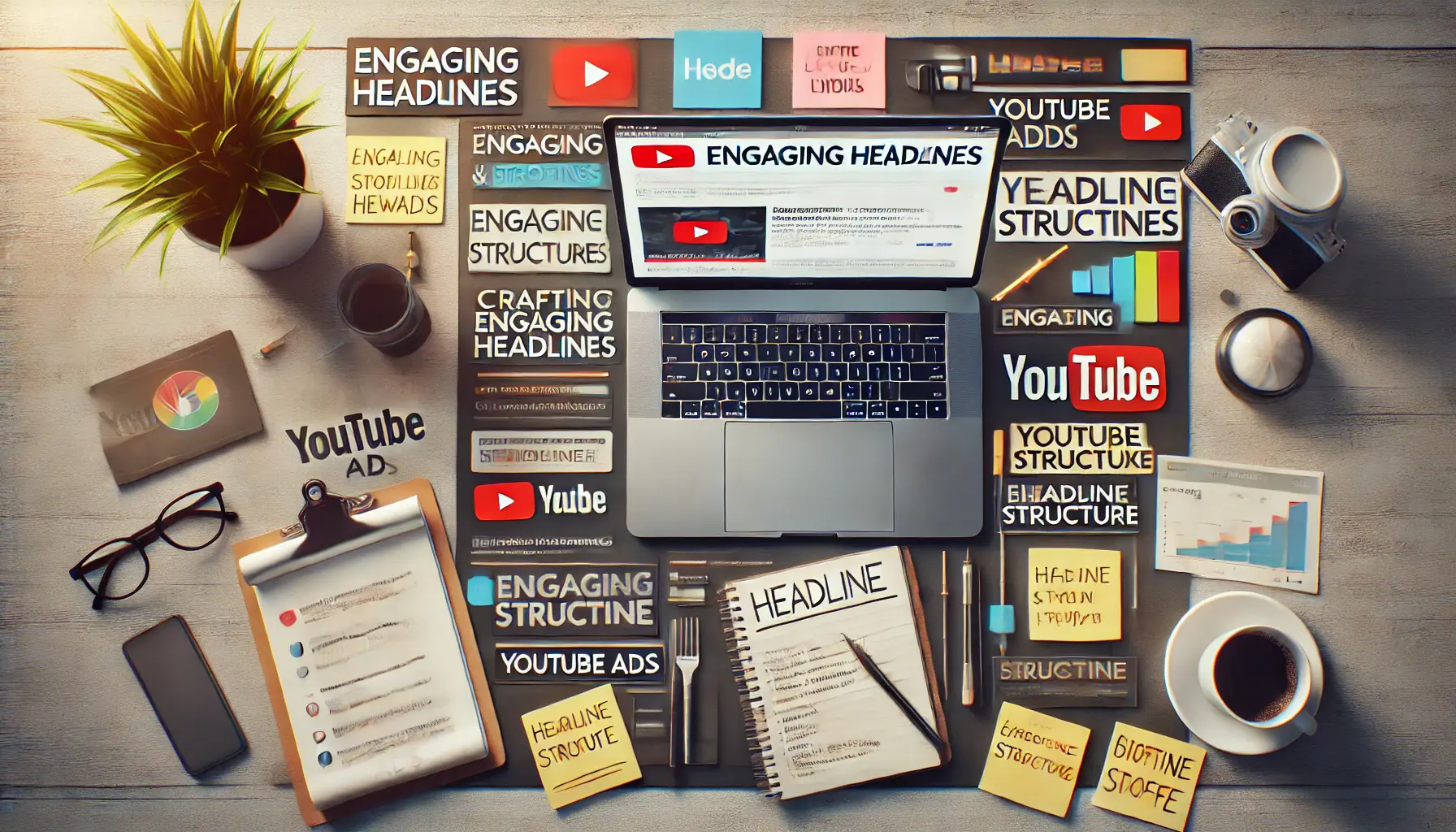
Workspace for brainstorming and crafting engaging headlines.
How to Craft Engaging Headlines
Writing an effective headline is both an art and a strategy.
A great headline is short, attractive, and relevant to your target audience.
Here are some ideas to consider for your YouTube ad headlines:
- Use power words: Words like “Discover,” “Unlock,” “Proven,” and “Exclusive” can instantly make your ad more compelling.
- Address a pain point: By touching on a common problem or challenge, you hook viewers who are looking for solutions. Example
- Create a sense of urgency: Urgent headlines can encourage viewers to take action quickly, as the opportunity might not last. Key phrases like “Limited Time Offer” or “Don’t Miss Out!” can increase engagement.
- Be concise and clear: Avoid long, complicated headlines. Use simple language so the viewer knows exactly what it’s about without needing to decipher it.

Workspace highlighting the relationship between keywords and ad headlines.
The Keyword to Ad Headline Relationship
Incorporating keywords into your headline makes it more relevant and searchable.
Keywords help ensure that your ad appears to the right audience and can improve its ranking in YouTube’s search results.
When choosing keywords, think about what your target audience may be searching for.
Tools like Google Keyword Planner and YouTube’s search suggestions can help you identify relevant keywords to enhance the effectiveness of your headline.
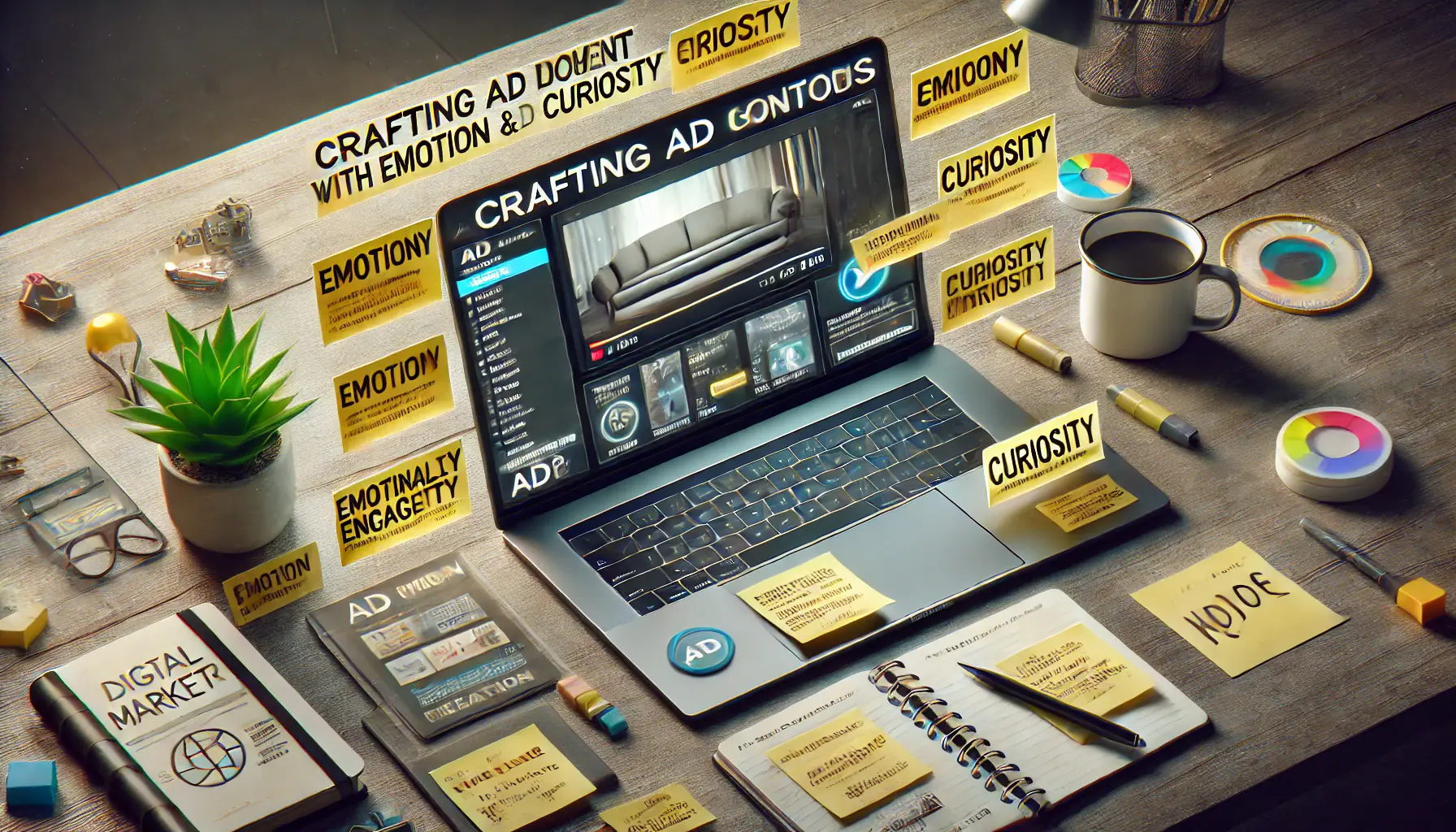
Workspace setup for crafting ads that evoke emotion and curiosity.
Hooking Your Viewers with Emotion and Curiosity
An attention-grabbing headline that resonates emotionally can make a significant difference in making your ad memorable.
Emotions like curiosity, excitement, or empathy can strongly influence viewer engagement.
Consider using questions or intriguing statements that spark curiosity, such as “What Happens When You Skip This Step?” or “Here’s How to Double Your Productivity in Minutes.” The right emotional appeal encourages viewers to stay engaged and interested in what your ad has to offer.
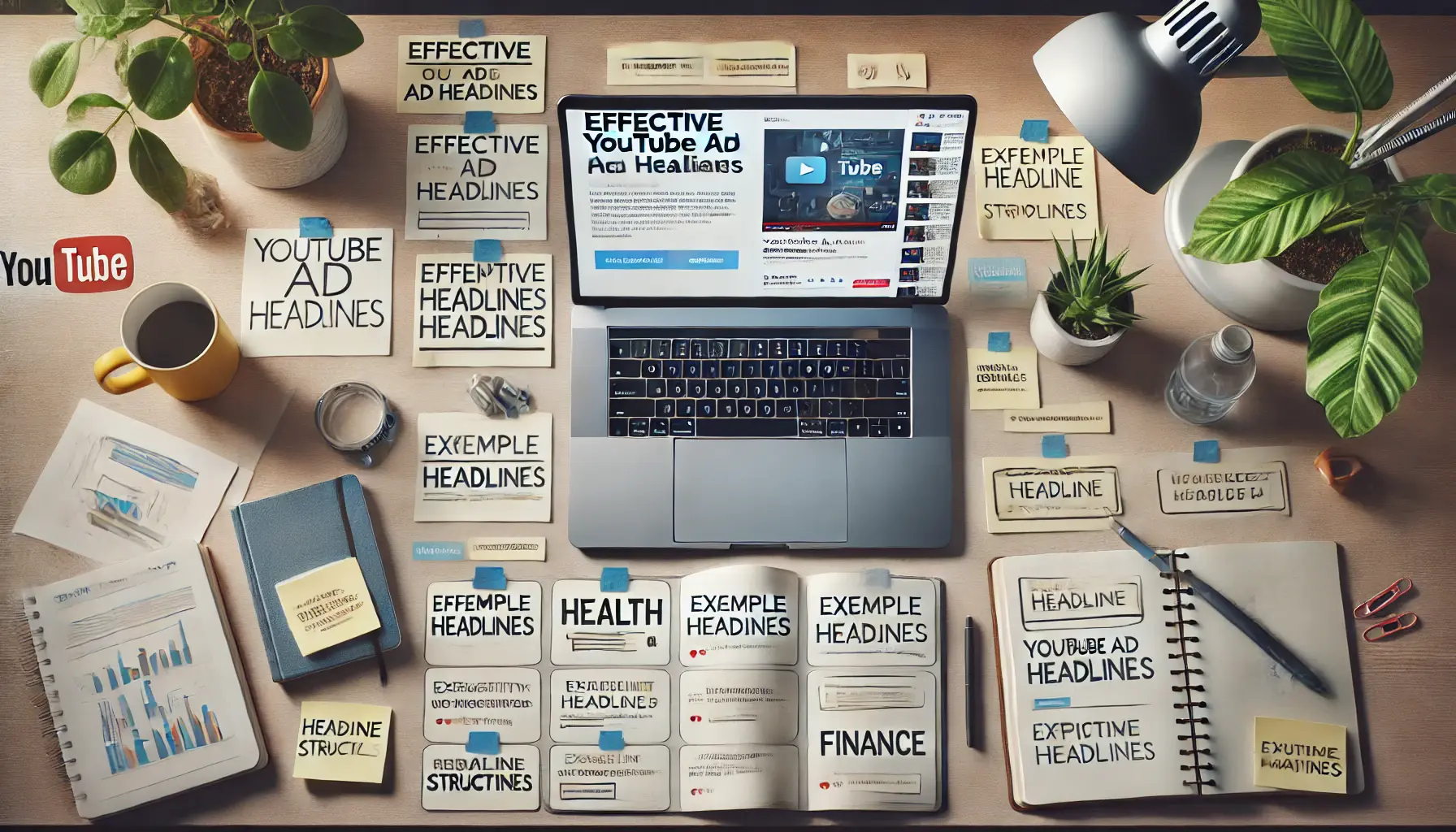
Workspace showcasing examples of compelling YouTube ad headlines.
Examples of Effective YouTube Ad Headlines
Looking at successful headlines can inspire creativity for your own ads.
Here are a few examples that have worked in various industries:
- Health and Wellness: “Transform Your Health with These Easy Steps”
- Productivity Tools: “Supercharge Your Efficiency with This One Tool”
- Financial Services: “Want to Lock Down Your Financial Future? Here’s How”
- E-commerce: “Exclusive Deals Inside – Shop Now!”
Experimenting with different headline structures can help you determine what resonates best with your target audience.
Your headline is a critical component of your ad because it captures viewers’ attention and entices them to keep watching.
Catchy headlines are vital to seizing viewer attention and setting the tone for your ad. Using power words and addressing pain points can help.
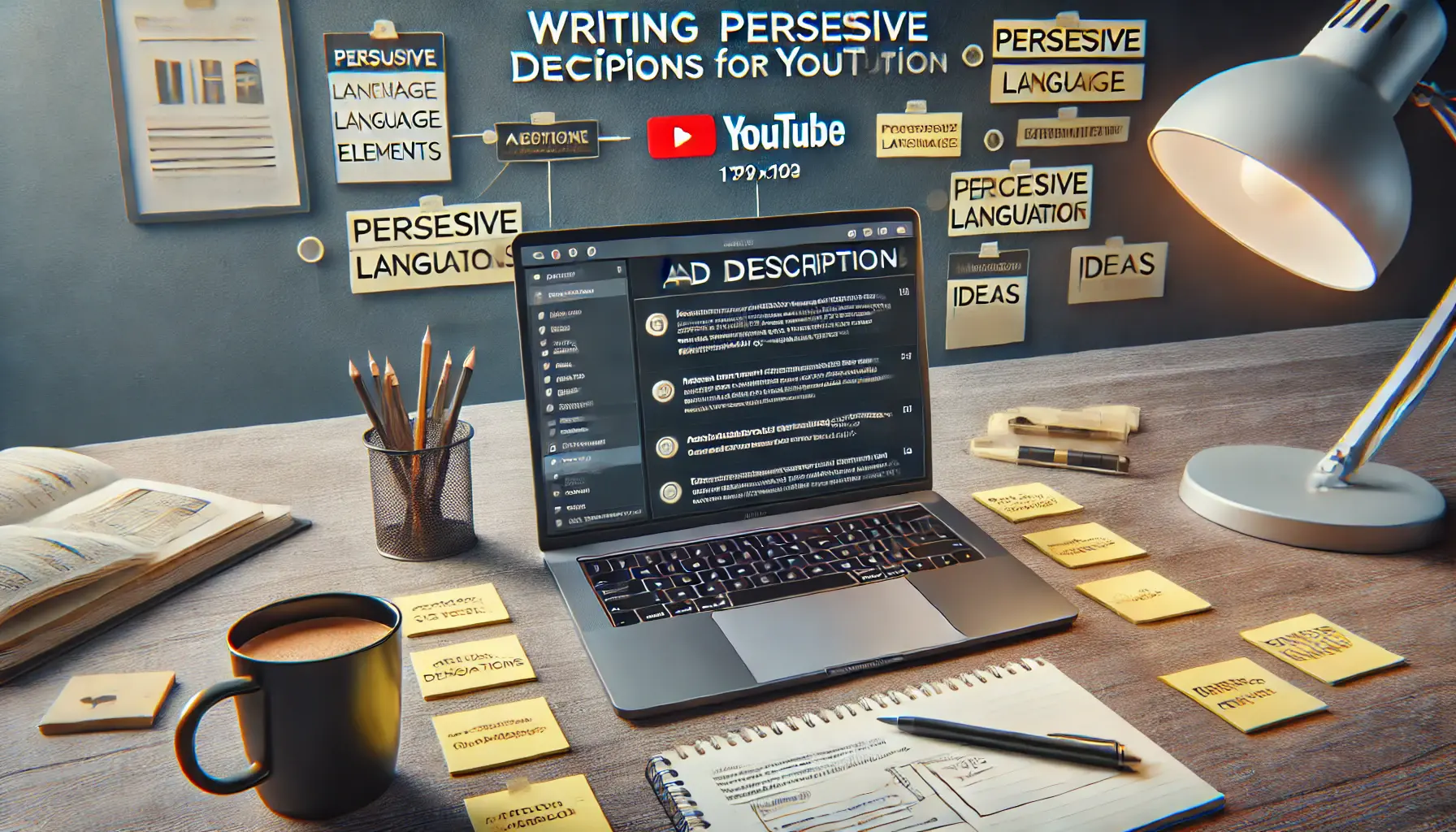
Workspace focused on crafting persuasive ad descriptions for YouTube.
Writing Ad Descriptions for Maximum Persuasion
While the headline might capture attention, the description in your YouTube ad provides context, explains what viewers can gain, and engages them enough to want to take action.
A well-crafted ad description complements your video content by showcasing the benefits of your product or service and explaining why viewers should engage further.
This description must be clear, persuasive, and directly address the viewer’s needs to serve as a powerful tool in maximizing your ad’s impact.
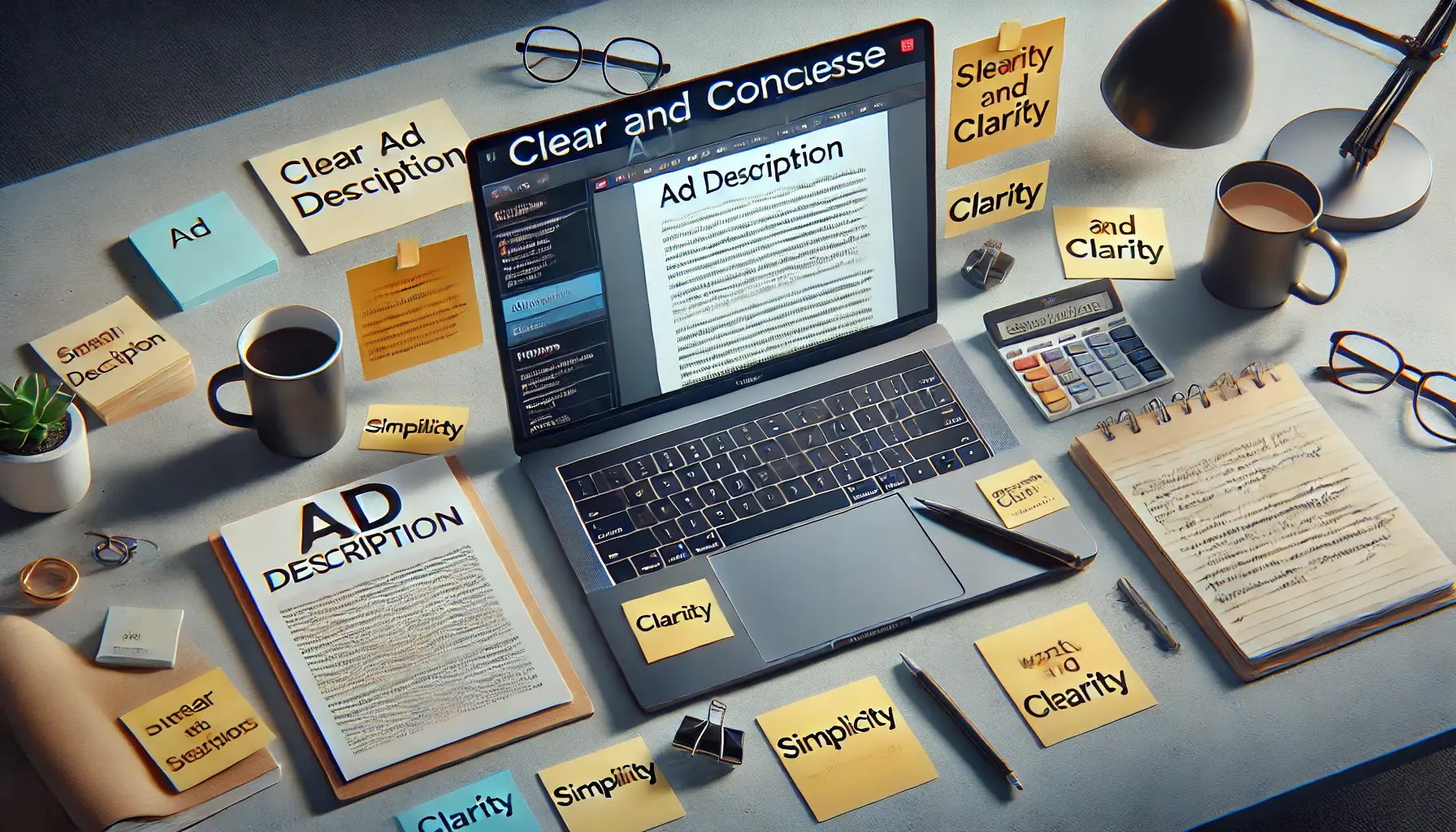
Workspace focused on crafting clear and concise ad descriptions.
Writing Clear and Concise Descriptions
Clarity is essential for ad descriptions.
Your description should communicate your message straightforwardly, avoiding excessive jargon or complexity.
A clear description allows viewers to quickly grasp what you’re offering and why it’s valuable to them.
Here are some tips for crafting clear, concise descriptions:
- Keep it concise: Write a description that’s easy to read at a glance. Avoid lengthy sentences or overly complex phrasing.
- Focus on the main benefit: Clearly state the primary advantage your product or service provides. This helps the audience immediately understand what’s in it for them.
- Avoid filler words: Words like “very,” “really,” and “just” can dilute your message. Stick to impactful language that communicates the essentials.
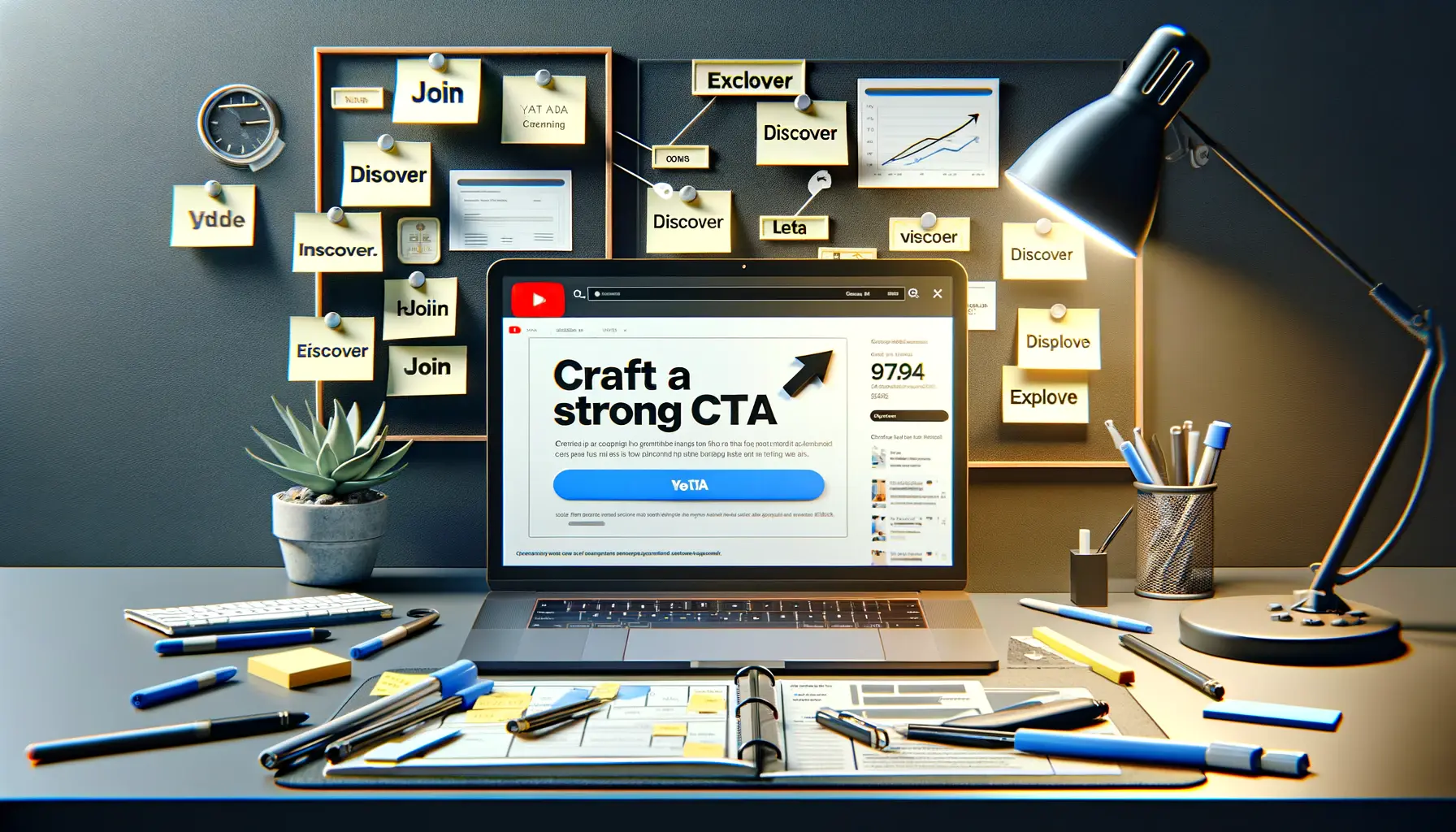
Workspace focused on crafting a strong call-to-action for ad engagement.
Including a Strong Call-to-Action (CTA) for Higher Engagement
A strong CTA can greatly enhance engagement by guiding viewers on what to do next.
Your CTA should be clear, action-oriented, and relevant to the purpose of your ad, whether it’s driving traffic to your website, encouraging app downloads, or prompting viewers to subscribe to your channel.
Consider these CTA tips:
- Use action-oriented phrasing: Phrases like “Learn More,” “Get Started,” or “Discover Now” can create a sense of direction and urgency.
- Align CTA with viewer intent: Ensure that your CTA matches what viewers are likely seeking. For example, “Shop Now” may be more effective than “Learn More” if you’re promoting a product.
- Limit CTAs to one or two: Having too many CTAs in one description can overwhelm viewers. Stick to one or two relevant actions for a more focused message.
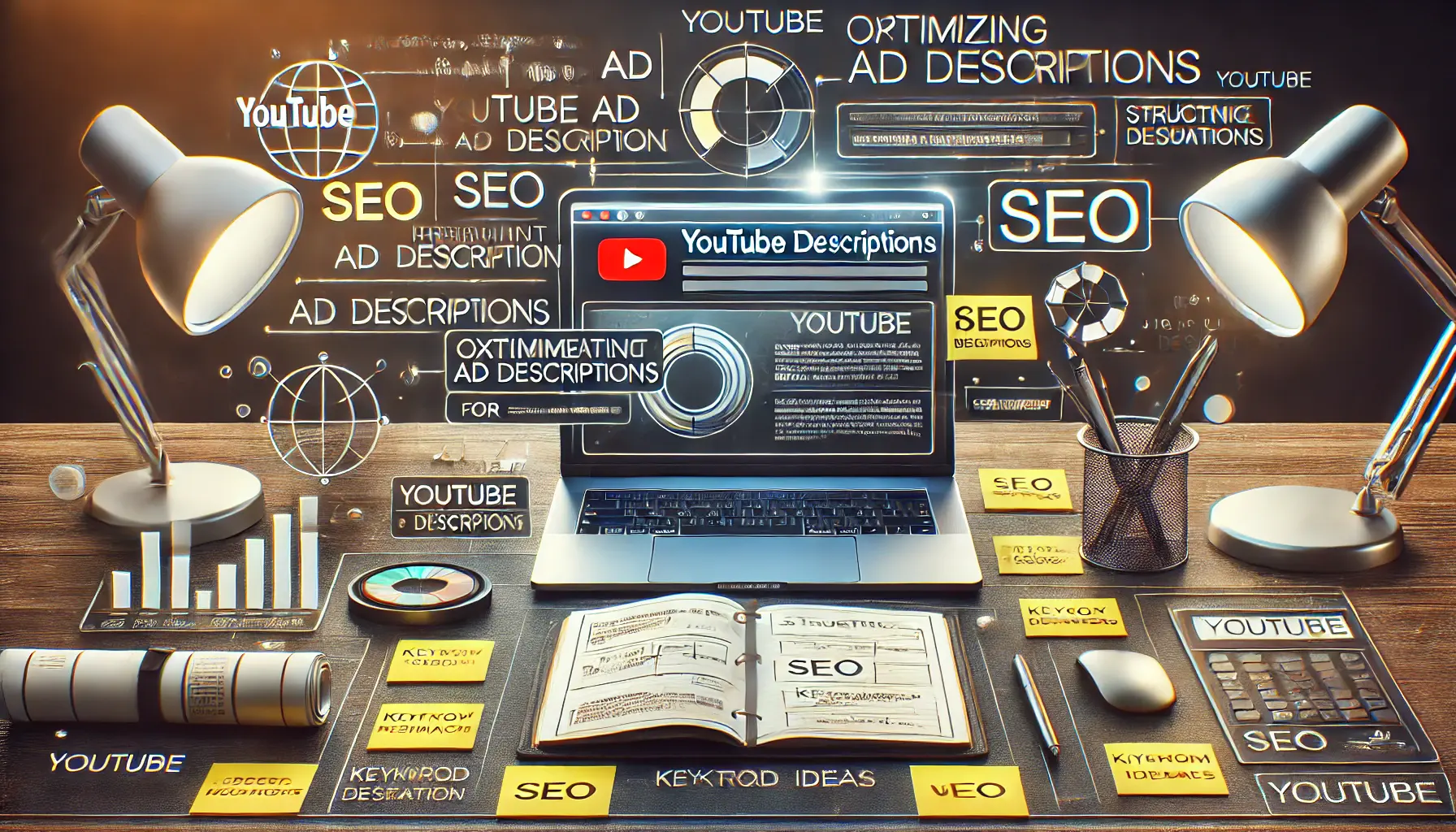
Workspace for optimizing YouTube ad descriptions for SEO.
Optimizing Descriptions for SEO
Optimizing your ad descriptions for SEOSearch Engine Optimization; a strategy to improve the visibility and ranking of online content in search engine results. helps broaden your reach.
Incorporate keywords naturally in your descriptions to make your ad appear in YouTube search results and attract more clicks.
Here’s how to effectively optimize descriptions:
- Identify relevant keywords: Use tools like Google Keyword Planner or YouTube’s search suggestions to find keywords that align with your audience’s search behavior.
- Place keywords strategically: Include keywords early in the description, where they are more likely to positively impact SEO. However, avoid keyword stuffing; the language should still flow naturally.
- Use tags and hashtags: Hashtags related to your content improve searchability, especially for trending topics or specific industries.
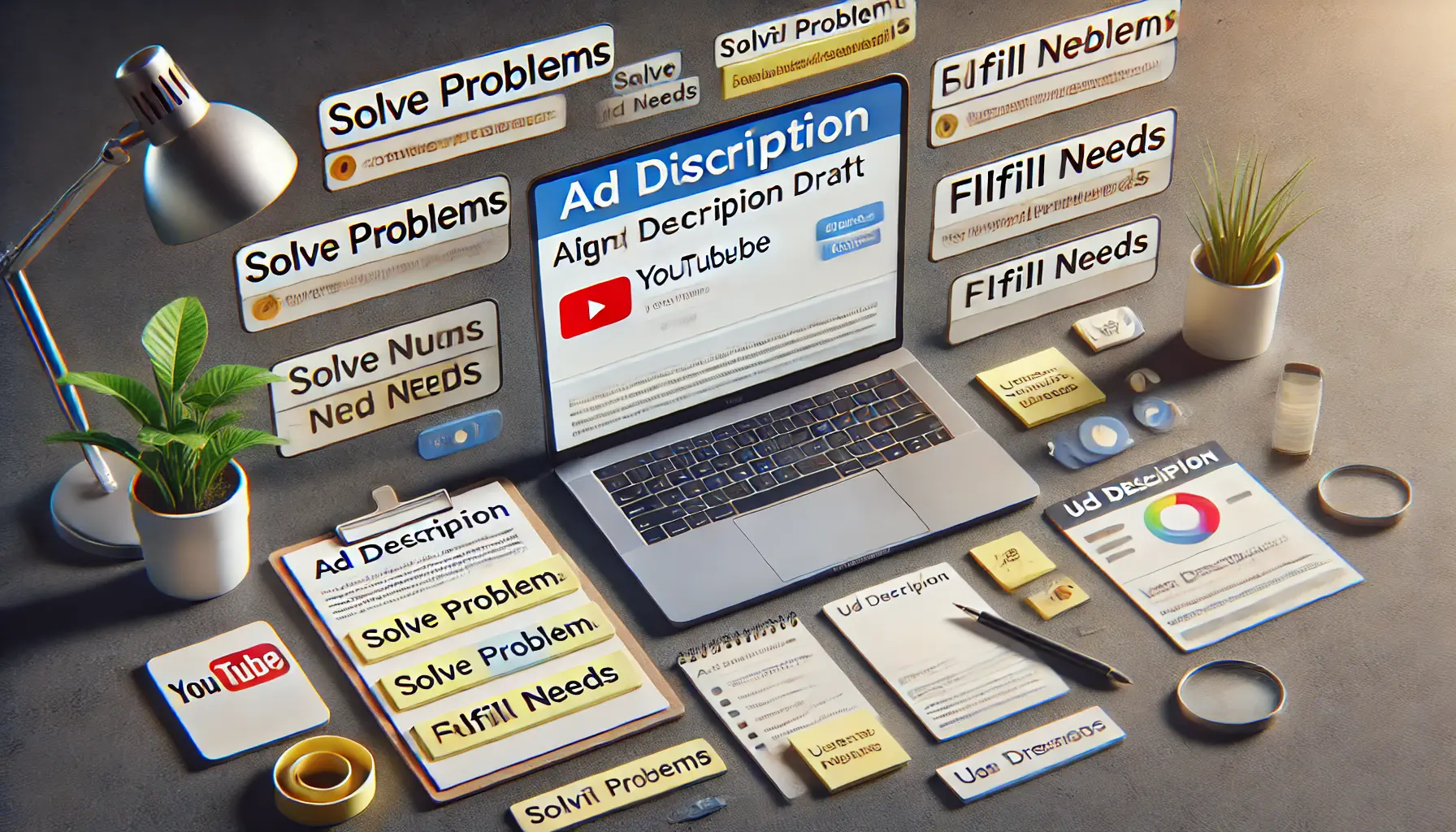
Workspace for crafting ad descriptions aligned with user intent.
Aligning Descriptions with User Intent
When creating ad descriptions, consider what your viewers are hoping to find.
If the description aligns with their intent, they’re more likely to watch the full ad and follow through with the desired action.
Here are some ways to match descriptions with user intent:
- Think like your audience: Put yourself in the viewer’s shoes. What questions might they have? What benefits would they care about most?
- Address pain points: Mention solutions to common problems your audience faces, positioning your product or service as the answer.
- Highlight value propositions: If your product is unique or offers special benefits, make sure these points are clear in the description.
Effective ad descriptions are a foundation of any successful YouTube ad campaign.
They nurture viewers’ interest, drive engagement, and improve conversionWhen a user takes the desired action in response to an ad, such as signing up or purchasing a product. rates.
Focusing on clarity, a strong CTA, SEO, and alignment with viewer intent allows you to maximize your ad descriptions for better campaign performance.
A persuasive ad description clearly communicates benefits and engages viewers to take action.
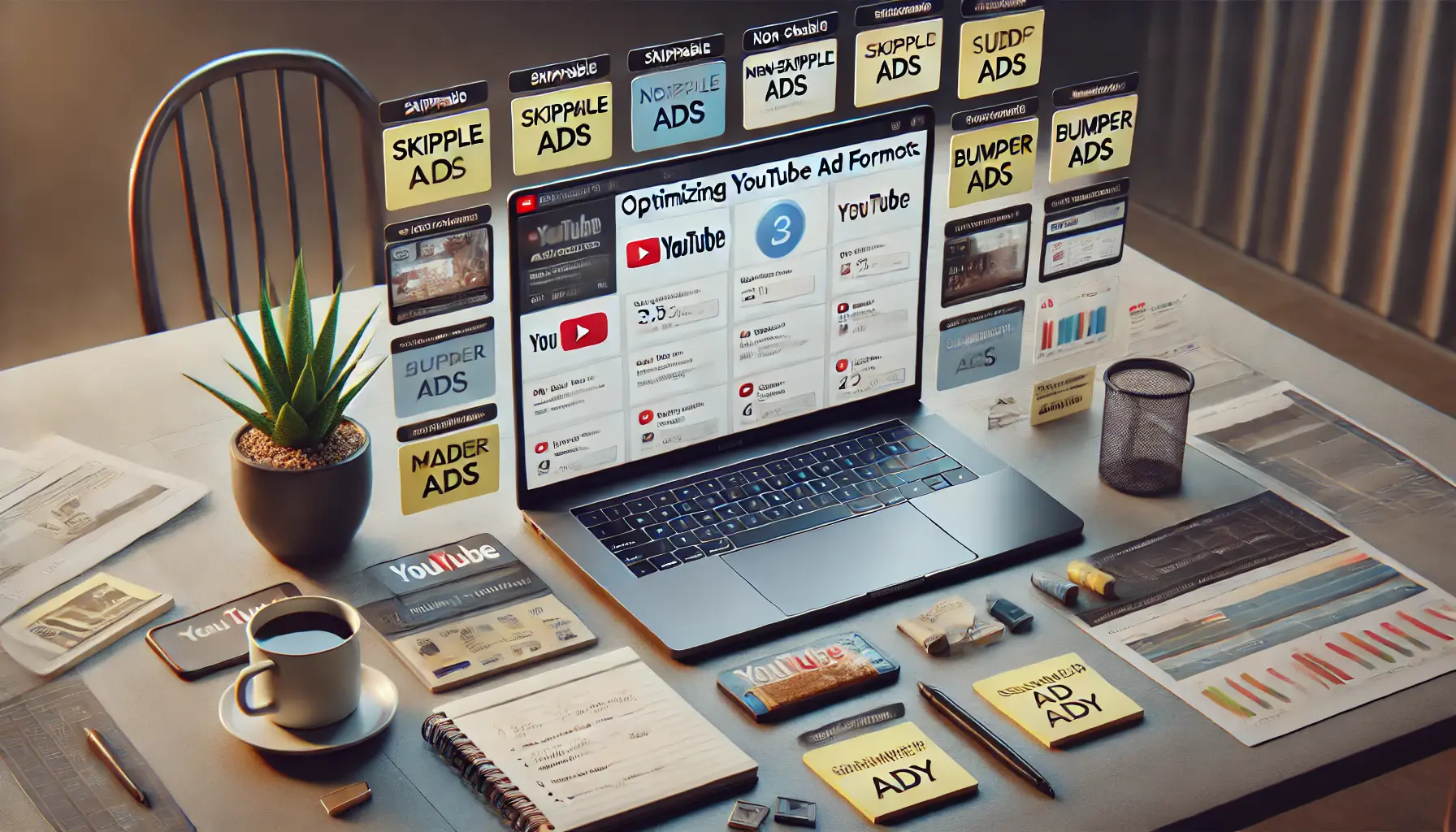
Workspace for optimizing ad copy across various YouTube ad formats.
Optimizing Copy for Various YouTube Ad Formats
YouTube offers different ad formats, each with unique characteristics and demands.
Knowing how to write specifically for each format is essential to making an ad perform effectively and engage with the audience.
Tailoring your message to suit each format makes it more relevant and effective, leading to better engagement and greater conversions.
Let’s look at the main YouTube ad formats and how you should optimize your copy for each.
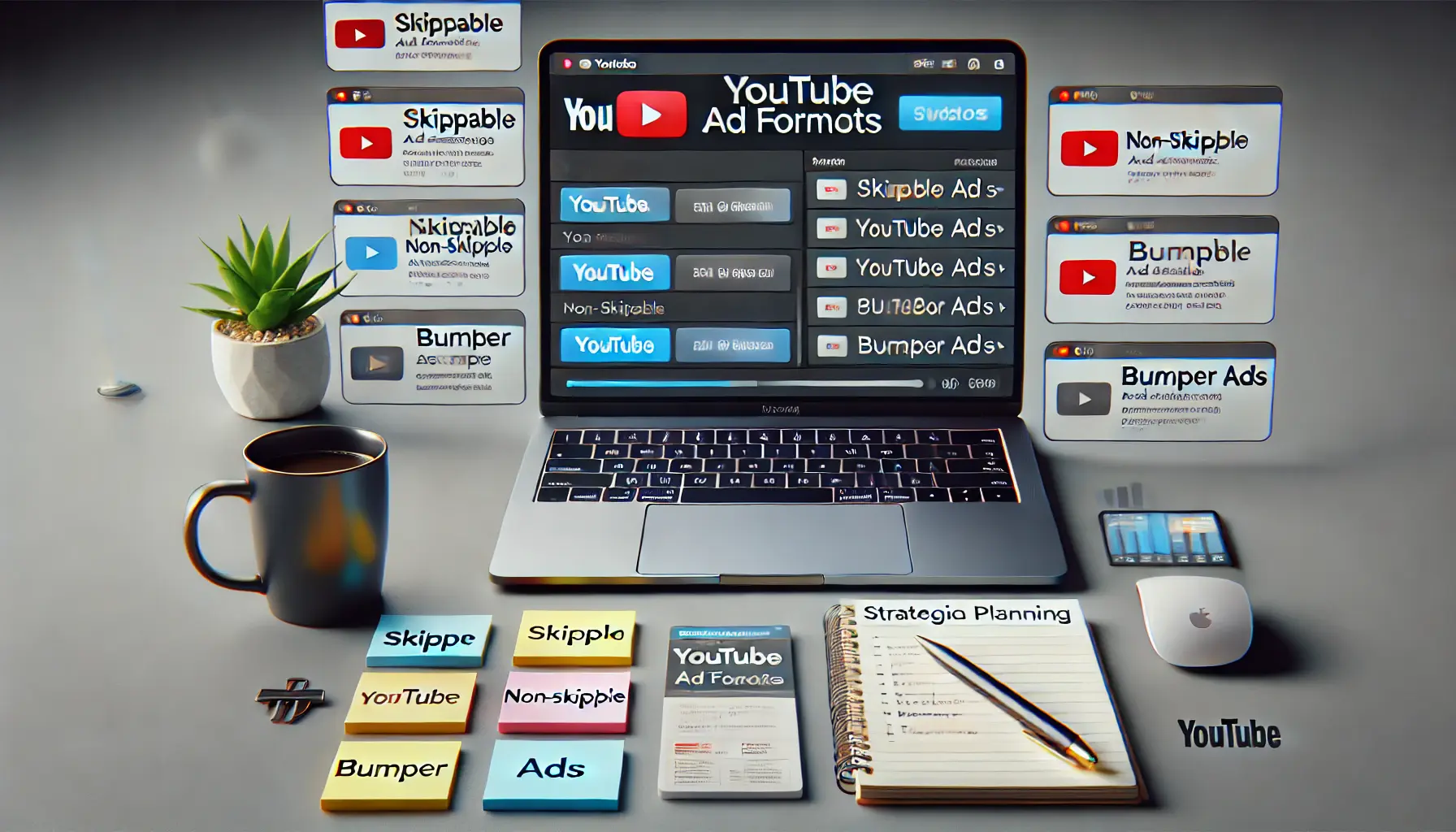
Workspace providing an overview of different YouTube ad formats.
Overview of Various YouTube Ad Formats
YouTube ads come in different formats, each serving a distinct purpose.
The most commonly used formats include:
- Skippable in-stream ads: These ads run before, during, or after videos and can be skipped after five seconds. They are ideal for longer messages, provided the initial seconds are engaging enough to keep viewers watching.
- Non-skippable in-stream ads: These ads also run before, during, or after videos but cannot be skipped and usually run for 15 seconds. The challenge here is to deliver a strong and concise message to maintain viewer engagement.
- Bumper ads: These are six-second, non-skippable ads designed for quick, memorable messaging. They are perfect for brand awareness and high-impact messaging.
- In-feed video ads: These ads appear in YouTube search results, on the YouTube homepage, and in the ‘watch next’ section. For successful in-feed ads, you need to persuade viewers to click and watch the video, making an engaging copy essential.
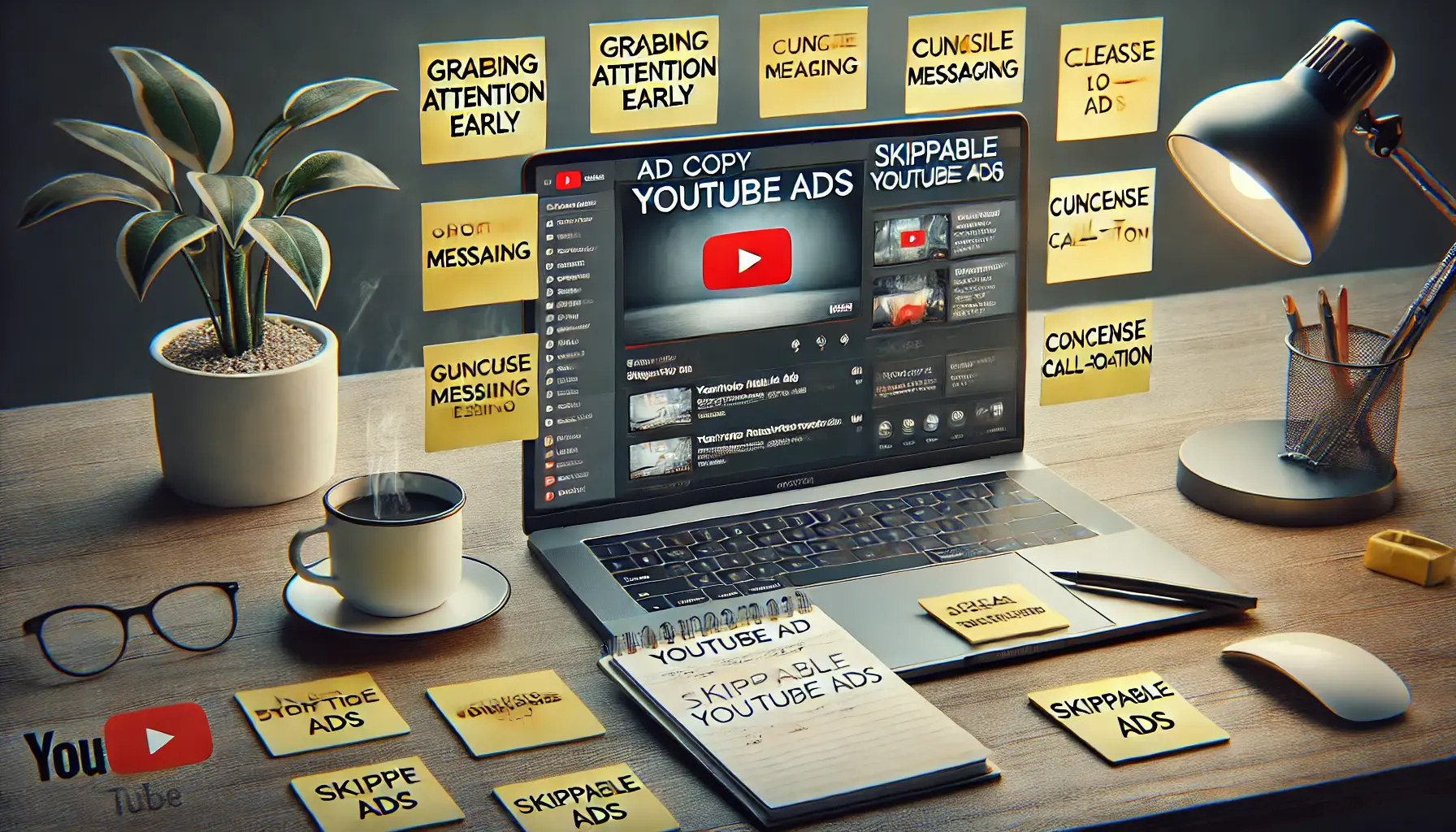
Workspace showcasing strategies for creating impactful skippable YouTube ads.
Ad Copy Strategies for Skippable Ads
Skippable ads give you a brief window to capture attention before viewers can skip.
Your primary goal is to hook viewers in the first five seconds.
Here are some strategies:
- Start with a strong hook: Begin with a question, surprising fact, or bold statement to grab attention immediately.
- Focus on viewer benefits: Clearly communicate the value or solution your product provides, encouraging viewers to stay engaged.
- End with a compelling CTA: After delivering your message, prompt viewers to take action, such as “Learn More” or “Get Started.”
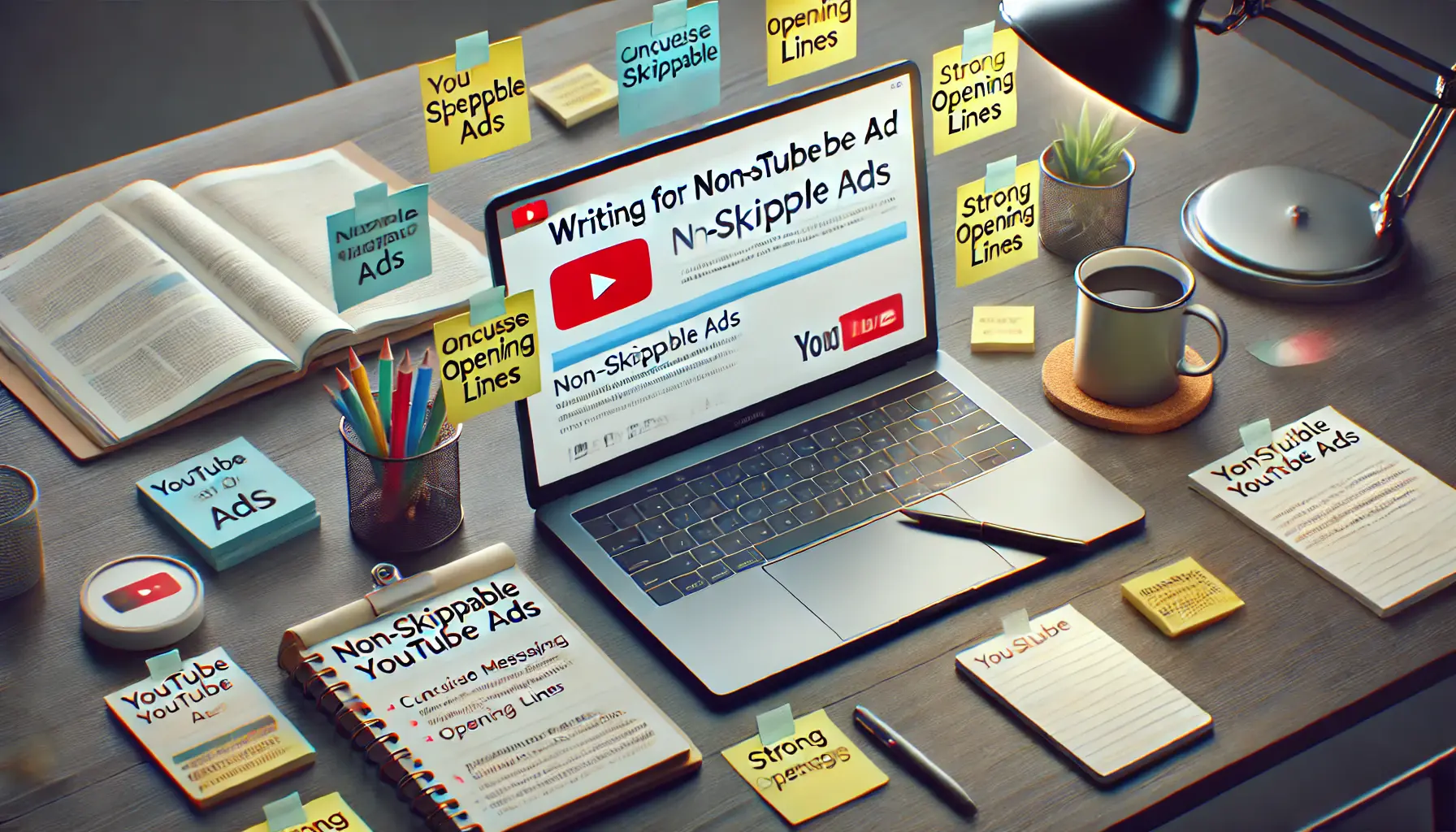
Workspace focused on creating effective non-skippable YouTube ads.
Writing for Non-Skippable Ads
With non-skippable ads, you have a captive audience for the entire duration, but it’s crucial to keep your message concise and impactful.
Non-skippable ads are typically 15 seconds, so every second counts.
- Deliver a clear, powerful message: Keep your message straightforward and focus on a single, strong point that resonates with viewers.
- Maintain a quick pace: Avoid lengthy introductions or complex details. Include only essential information that drives your point home.
- Use an assertive CTA: Since viewers must watch the full ad, end with a CTA that drives action and leaves a lasting impression.
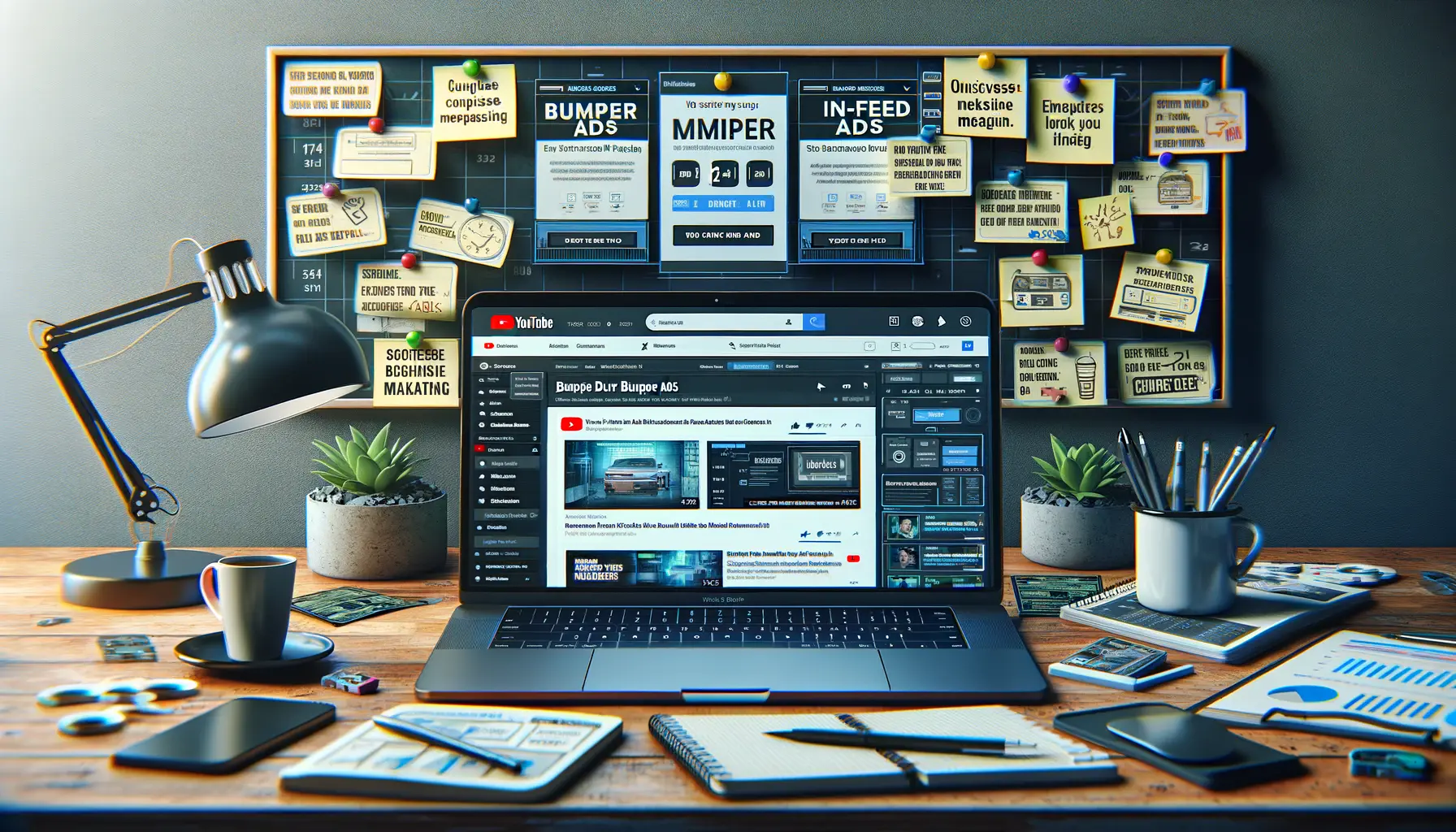
Workspace focused on best practices for YouTube bumper ads and in-feed ads.
Best Practices for Bumper Ads and In-Feed Ads
Bumper ads and in-feed ads require unique approaches due to their format and placement.
Here’s how to craft your copy for these types:
Bumper Ads
Bumper ads are just six seconds long, so the copy needs to be concise and memorable.
Focus on a single, impactful message.
- Prioritize brand messaging: Make your brand name or logo prominent so viewers instantly recognize your brand.
- Use catchy, memorable language: Choose words that are easy to remember and create a strong response.
- Emphasize visuals: Bumper ads are highly visual, so pair your copy with eye-catching imagery.
In-Feed Ads
In-feed ads are designed to encourage clicks, so your copy should be enticing and informative.
- Write an engaging headline: The headline should spark curiosity or clearly state the benefit of clicking to watch the full video.
- Keep descriptions brief: Provide just enough information to spark interest without giving everything away.
- Include a CTA in the description: Encourage viewers to click by using actionable language like “Watch Now” or “See How.”
Optimizing your ad copy for each format can improve viewer engagement, boost click-through rates, and make your YouTube campaigns more successful.
Tailor your approach to fit each format, and you’ll be able to create ads that maximize the potential of each unique ad type on YouTube.
Each ad format on YouTube requires tailored ad copy to maximize engagement, whether for skippable, non-skippable, bumper, or in-feed ads.
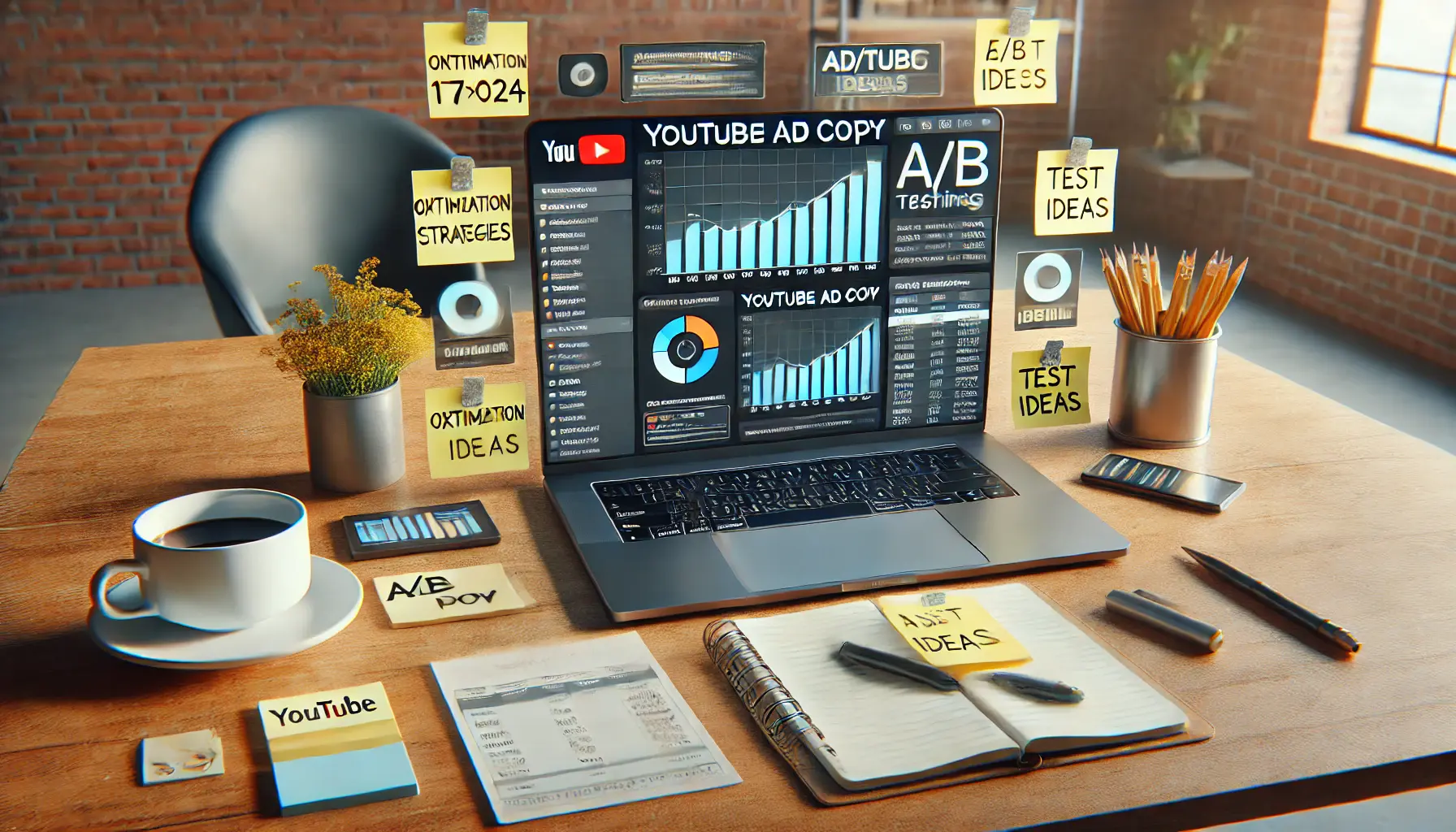
Workspace focused on testing and optimizing YouTube ad copy performance.
Testing and Optimizing Your YouTube Ad Copy
Even the most intricately designed ad copy needs testing and continuous improvement.
Testing helps you discover what truly works with your target audience, enabling you to iterate on messaging to improve ad performance.
By experimenting with different variations and closely analyzing key metricsData points that help evaluate the performance of a marketing campaign, such as clicks, conversions, and view duration., you can make data-driven adjustments to maximize the effectiveness of your YouTube ad copy.
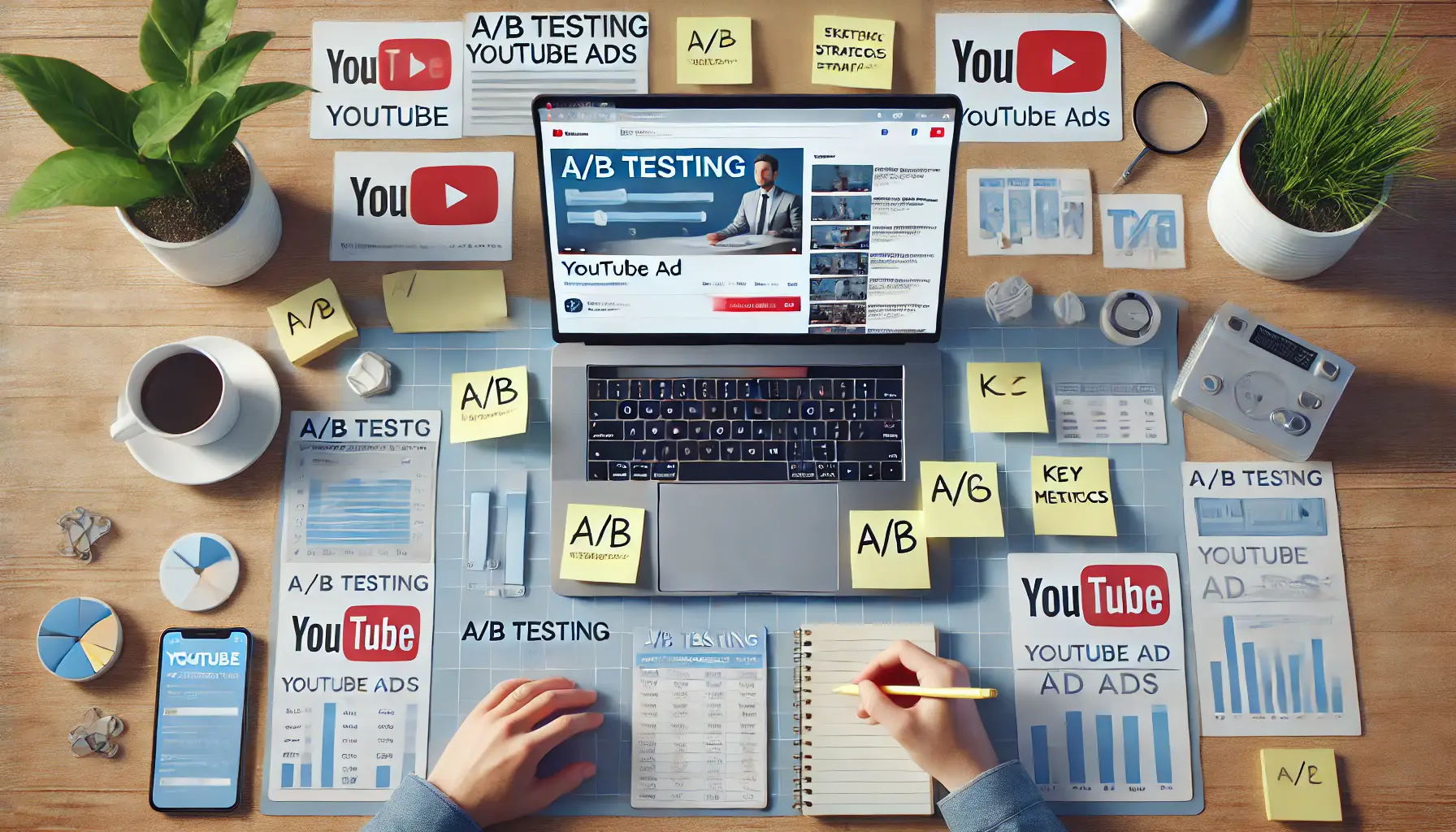
Workspace focused on A/B testing to optimize YouTube ad performance.
A/B Testing to Lift Ad Performance
A/B testing, or split testing, is a reliable way to evaluate which copy elements resonate best.
You do this by creating two or more versions of your ad with slight variations in copy elements, such as the headline, CTA, or description.
Running these variations side by side allows you to determine which version performs best.
- Test one element at a time: To accurately assess what’s working and what’s different, test only one item of the copy each time, such as the headline or the CTA.
- Have metrics for comparison: Track CTR, view duration, and conversion rates to gauge which version is most effective.
- Repeat and refine: A/B testing is an ongoing process. Continually think of new ideas to test, and refine your copy based on the results to keep optimizing performance.
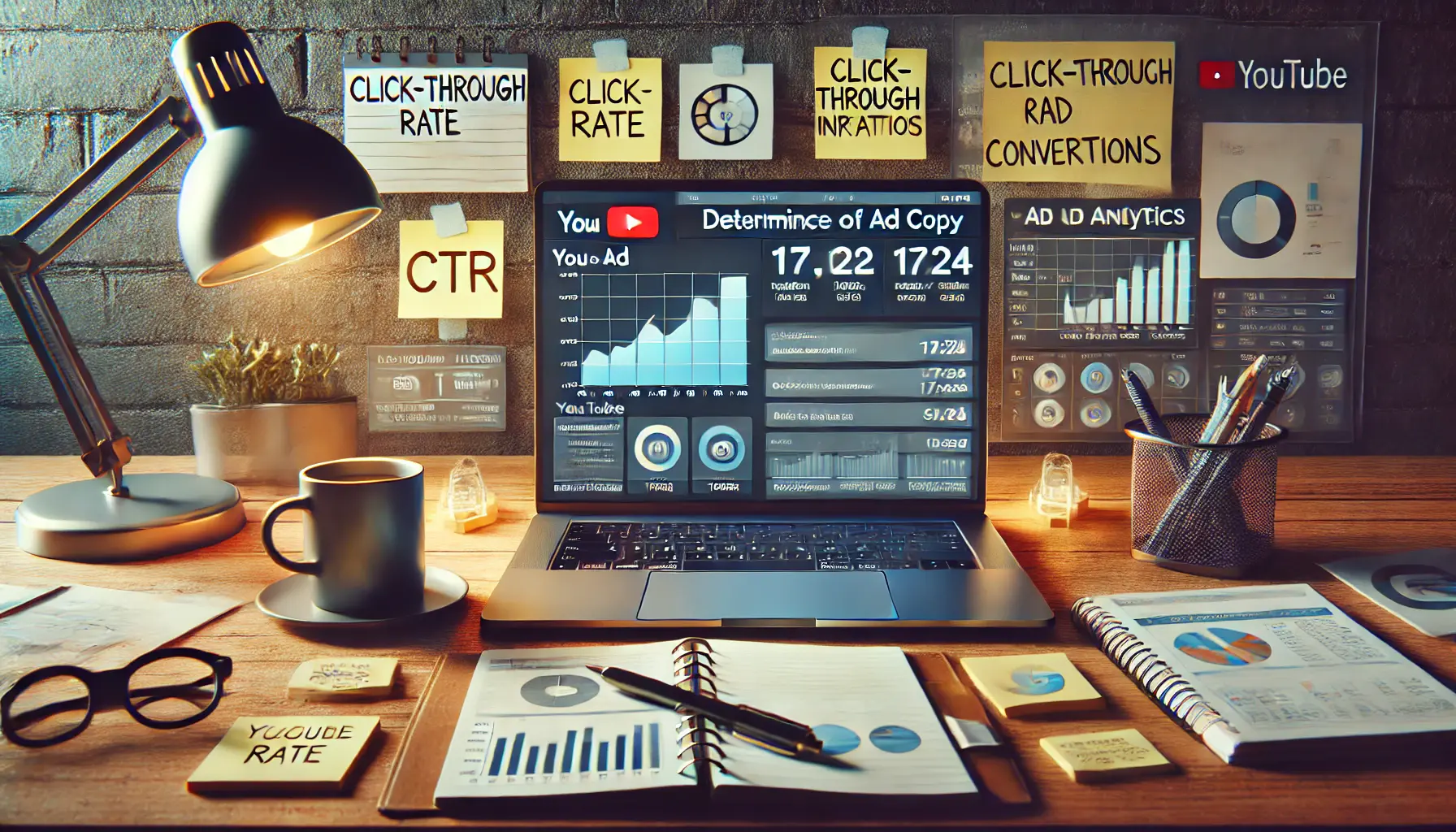
Workspace for analyzing metrics to evaluate the effectiveness of ad copy.
Analyzing Metrics to Determine Copy Effectiveness
Tracking key performance metrics provides insights into how well your ad copy is performing.
Some essential metrics to monitor include:
- Click-through rate (CTR): A high CTR indicates that your copy is engaging viewers and motivating them to click.
- View duration: This metric shows how long viewers stay engaged with your ad. Longer view times suggest that the copy and content are resonating well.
- Conversion rate: The conversion rate reflects the percentage of viewers taking your desired action, such as visiting a website or making a purchase, showing how persuasive your copy is.
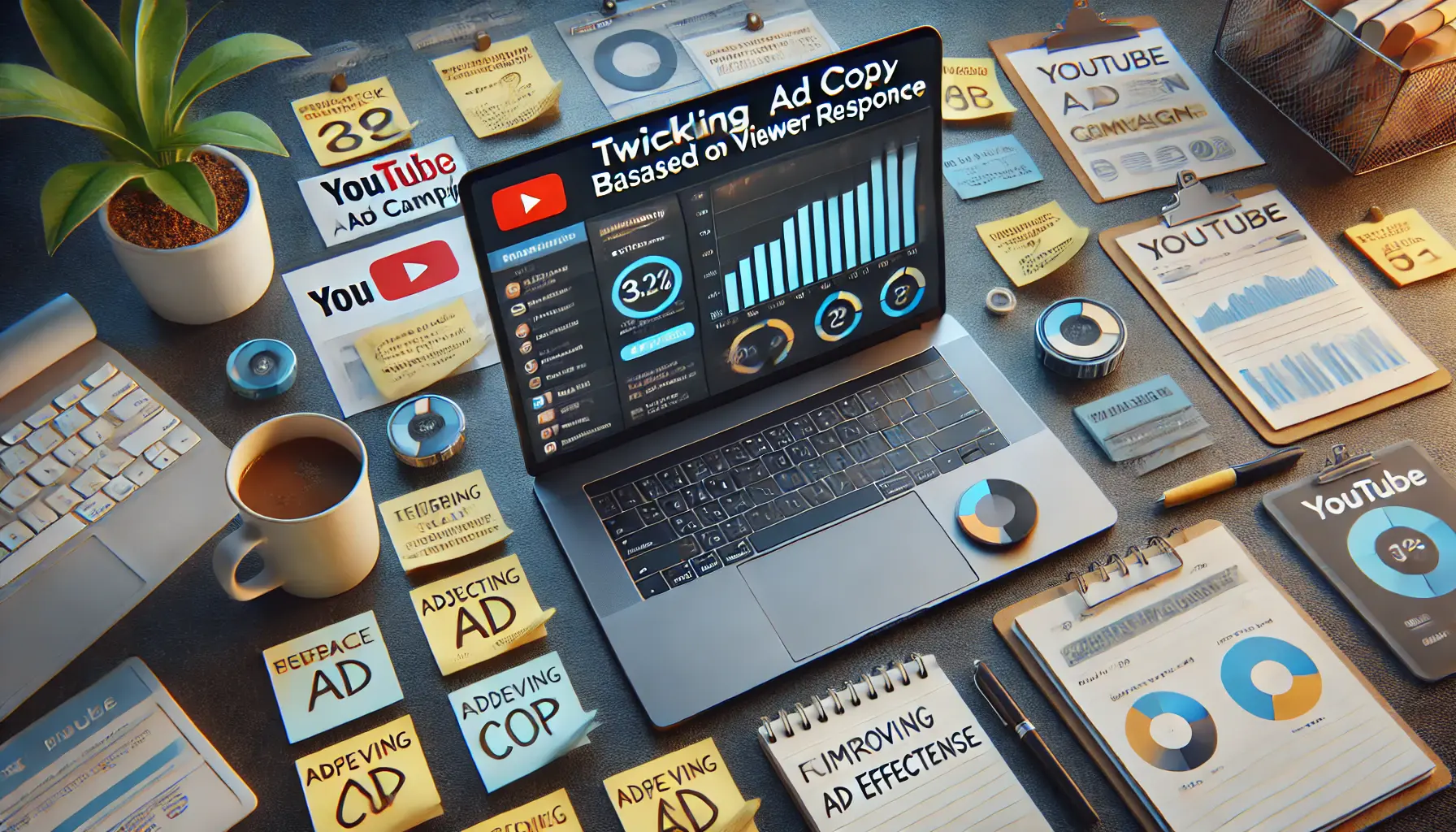
Workspace focused on tweaking ad copy based on viewer feedback.
Tweaking Your Ad Copy According to Viewer Response
Viewer feedback can provide insights into what’s working and what needs improvement in your ad copy.
Consider these approaches:
- Reading comments and reviews: Viewers often leave comments on YouTube ads, sharing what they liked or found unclear.
- Conducting surveys or polls: Engage your audience in surveys or polls to gather feedback on their preferences and perceptions of your ad content.
- Using social listening tools: Monitor social media platforms for discussions related to your ad content or brand. This feedback can reveal audience sentiment and guide you in adjusting your messaging.
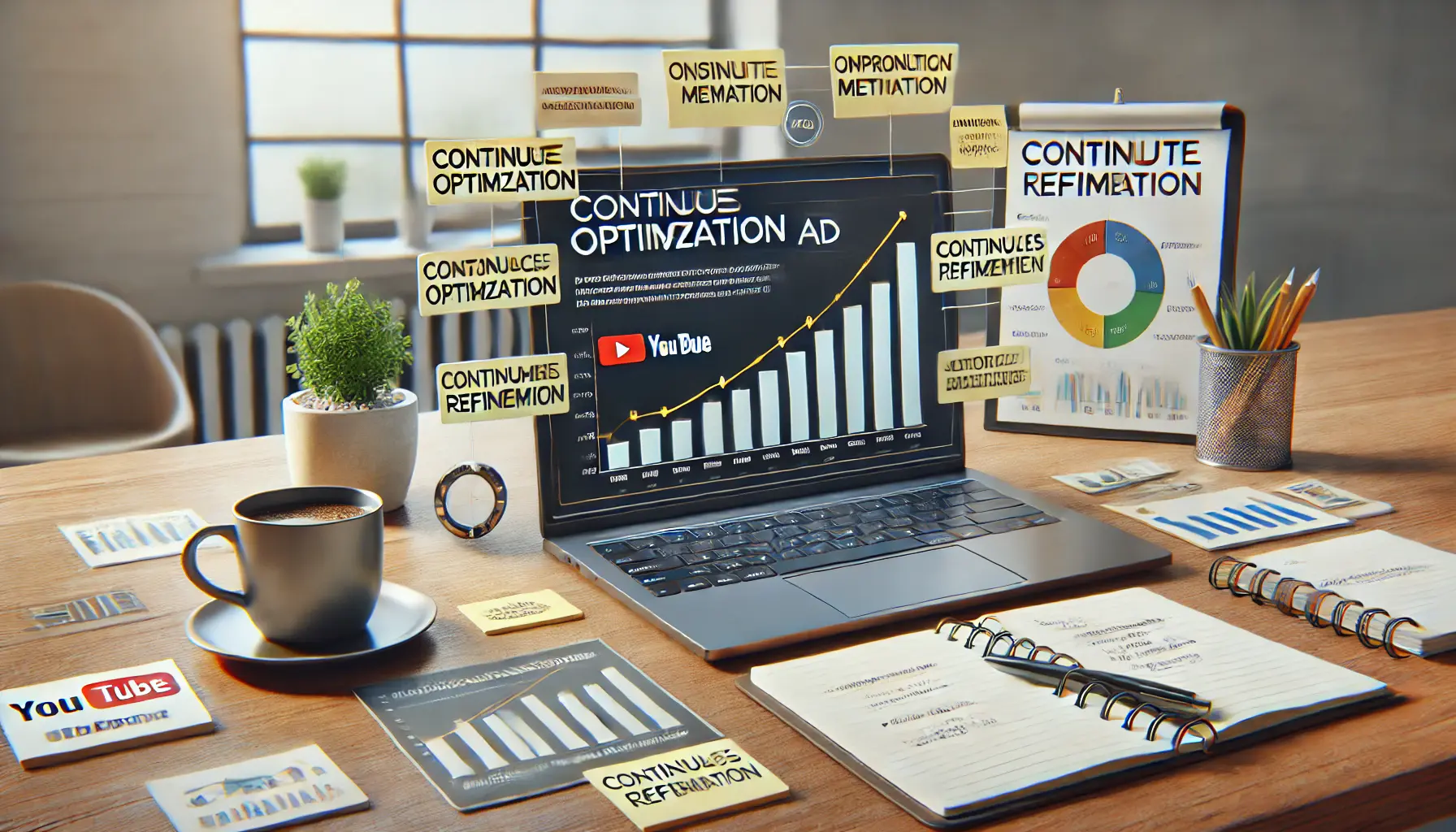
Workspace focused on continuous optimization of YouTube ad copy.
Strategies for Continuous Optimization
Improving your YouTube ad copy is a continuous process.
As trends evolve and audience preferences shift, staying proactive in refining your approach is essential.
Here are some strategies to keep your copy fresh and effective:
- Stay in tune with industry trends: Keep up to date with the latest trends in digital advertising and adjust your ad copy as new viewer preferences emerge over time.
- Try new ideas: Test new copy styles, tones, or messaging techniques periodically to understand what resonates best with your target audience.
Testing, analyzing metrics, gathering feedback, and being adaptable all contribute to continuous improvement of your YouTube ad copy, ensuring better engagement and results over time.
Regularly testing and optimizing ad copy through A/B testingA method of comparing two versions of an ad to determine which one performs better. and tracking key metrics enhances ad performance over time.
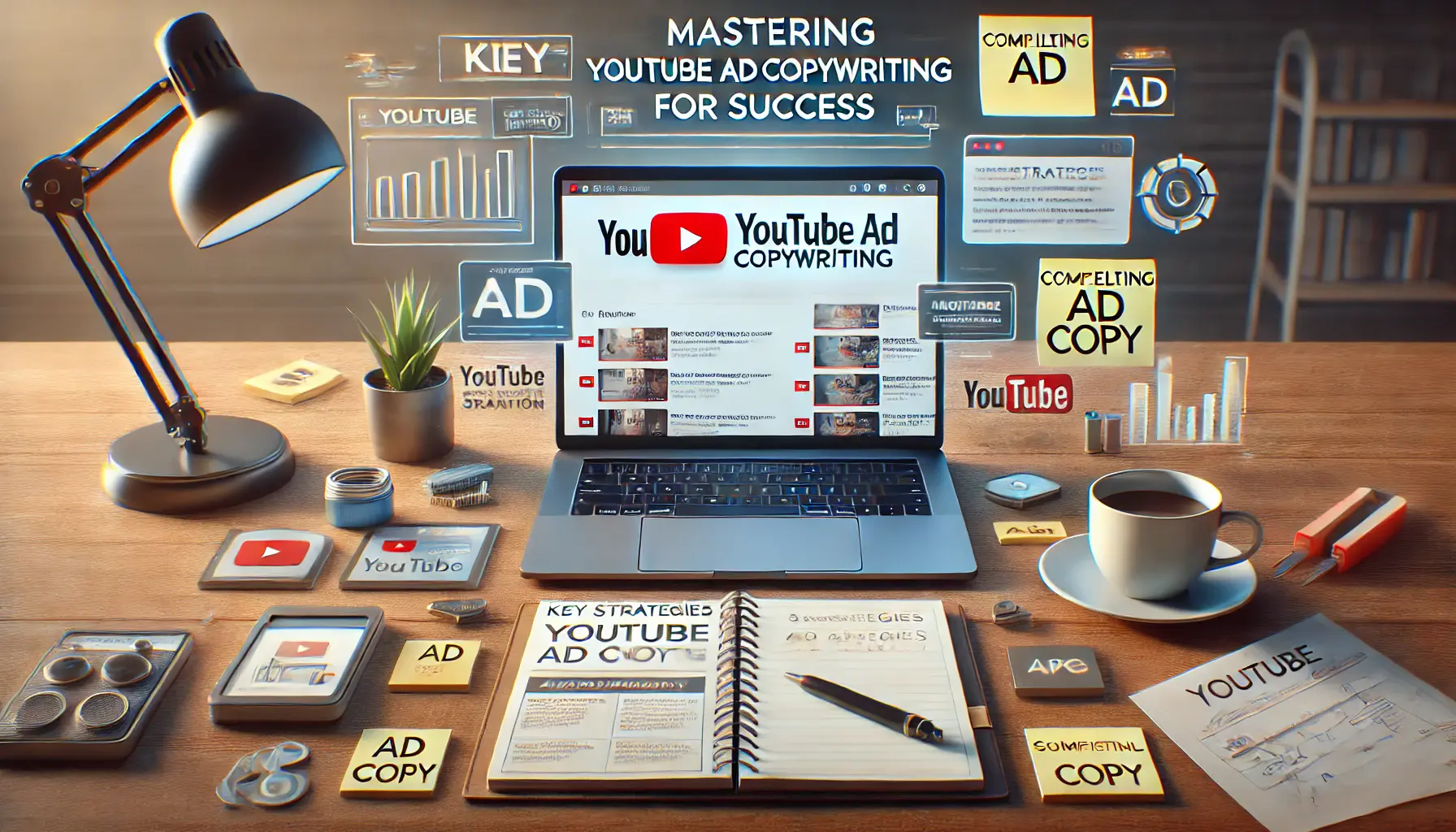
Workspace for mastering YouTube ad copywriting for success.
Mastering YouTube Ad Copywriting for Success
Writing effective YouTube ads requires more than just visually appealing content; it involves crafting a copy that speaks directly to the viewer, encourages engagement, and drives action.
This article has explored some of the key strategies for creating effective ad copy—from understanding the unique requirements of each ad format to continually testing and improving your approach.
Every component of ad copywriting—headlines, descriptions, calls-to-action, and format-specific adjustments—contributes to making your ad more compelling and impactful for your audience.
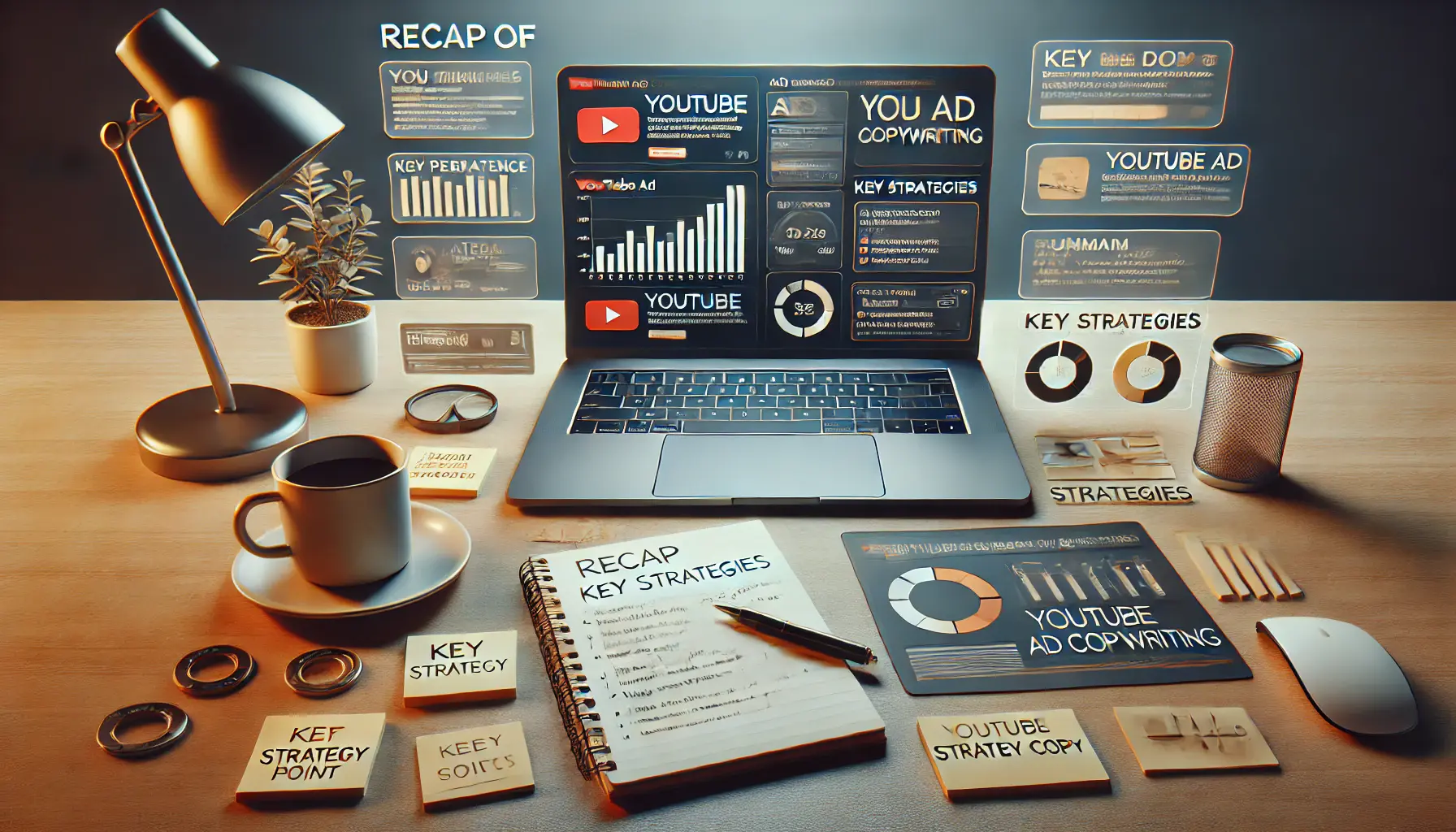
Workspace reflecting a recap of key YouTube ad copywriting strategies.
Recap of Key Strategies
To ensure that your YouTube ad copy reaches and resonates with viewers, here’s a quick rundown of the key strategies covered in this article:
- Understand the Fundamentals: Craft ad copy that resonates with YouTube’s unique platform and aligns with how its audience consumes content. Balancing clarity with creativity is essential for making your message stand out in a short time.
- Write Compelling Descriptions: Well-written descriptions add context, communicate benefits, and include clear calls-to-action to guide viewers to the next step.
- Tailor Your Copy for Each Ad Format: Adjust your copy to fit each unique format, whether skippable, non-skippable, bumper, or in-feed ads, to ensure optimal performance.
- Test and Improve Continuously: Use A/B testing, analyze essential metrics, and gather viewer feedback to fine-tune your ad copy for ongoing improvement.
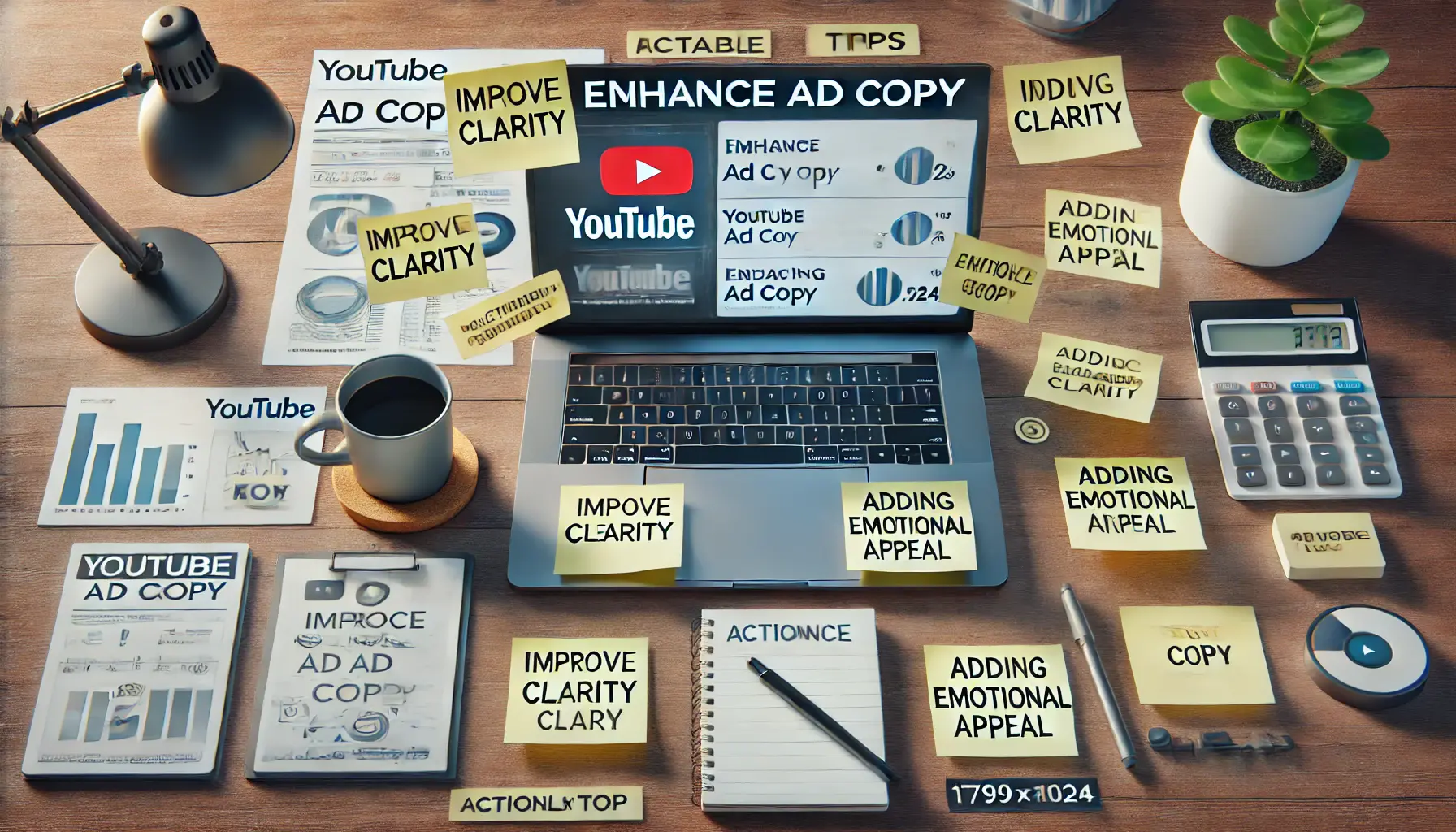
Workspace focused on actionable tips for enhancing YouTube ad copy.
Actionable Tips to Enhance Your Ad Copy
To help you achieve the best results, here are a few actionable tips you can apply to strengthen your YouTube ad copy:
- Focus on Your Audience: Always write with your target audience in mind. Address their needs, interests, and pain points to create a connection that resonates.
- Prioritize Clarity: Keep your copy clear and concise. Avoid overloading it with unnecessary jargon or details that might confuse viewers.
- Incorporate Keywords Naturally: Applying keywords helps make your ad discoverable and relevant. Use keywords in headlines, descriptions, and CTAs in a way that feels natural.
- Monitor and Adjust Regularly: Track ad performance and make adjustments based on the insights gathered from metrics and feedback.
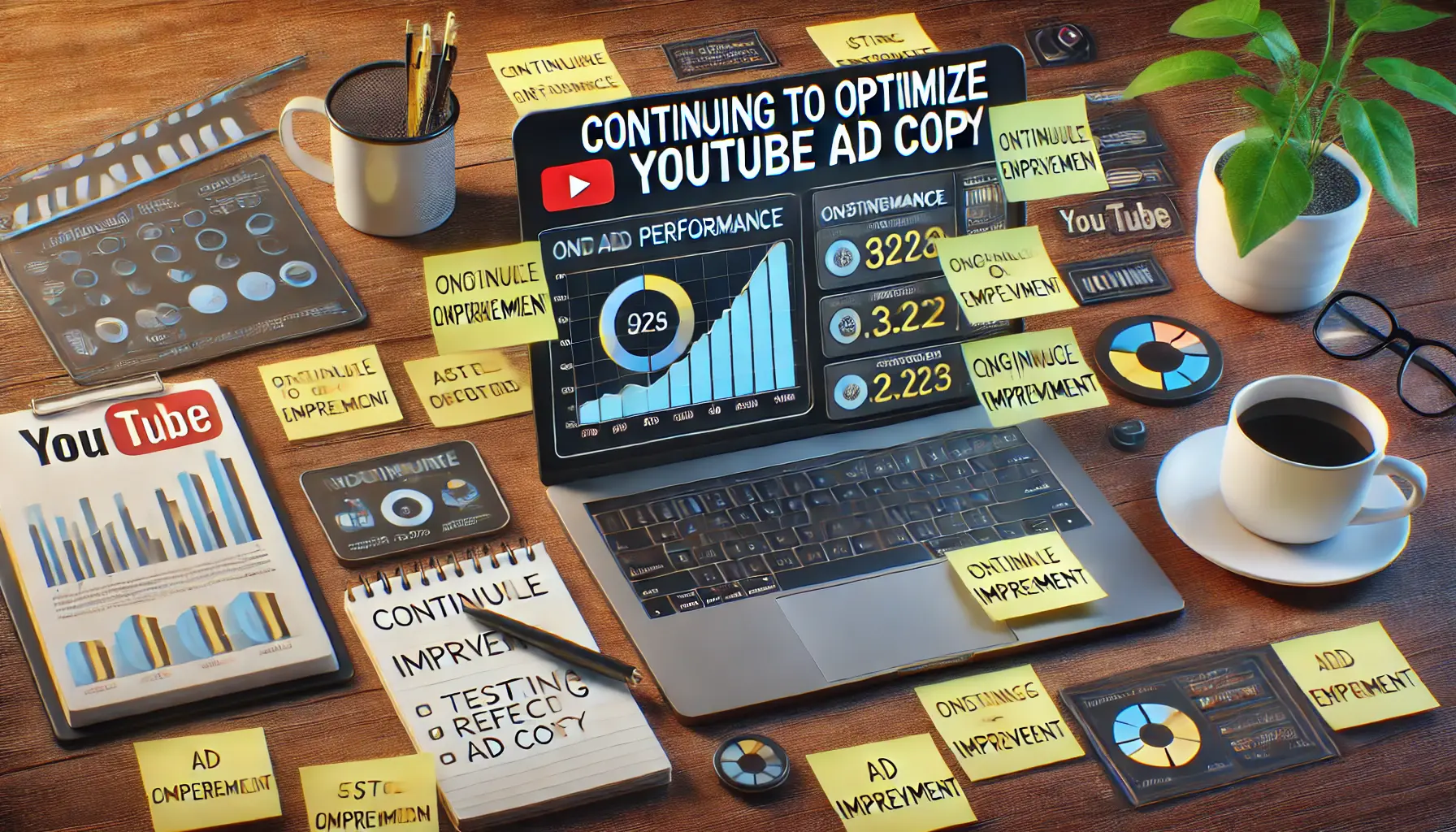
Workspace focused on continuous optimization of YouTube ad copy.
Continuing to Optimize Your YouTube Ad Copy
Writing YouTube ad copy is an evolving process, with viewer preferences and digital marketing trends constantly changing.
The ability to adapt your approach over time ensures that your ads remain relevant, engaging, and effective.
By applying the strategies discussed in this article, you can create ads that capture attention, drive viewers to take action, and ultimately increase engagement and conversions on the platform.
In essence, the best YouTube ad copywriting combines thoughtful planning, targeted messaging, and adaptability.
Embracing this approach will allow you to create ads that cut through the noise and leave a lasting impact in today’s competitive digital space.
Effective YouTube ad copywriting combines planning, strategic messaging, and continuous adaptation to drive engagement and conversions.
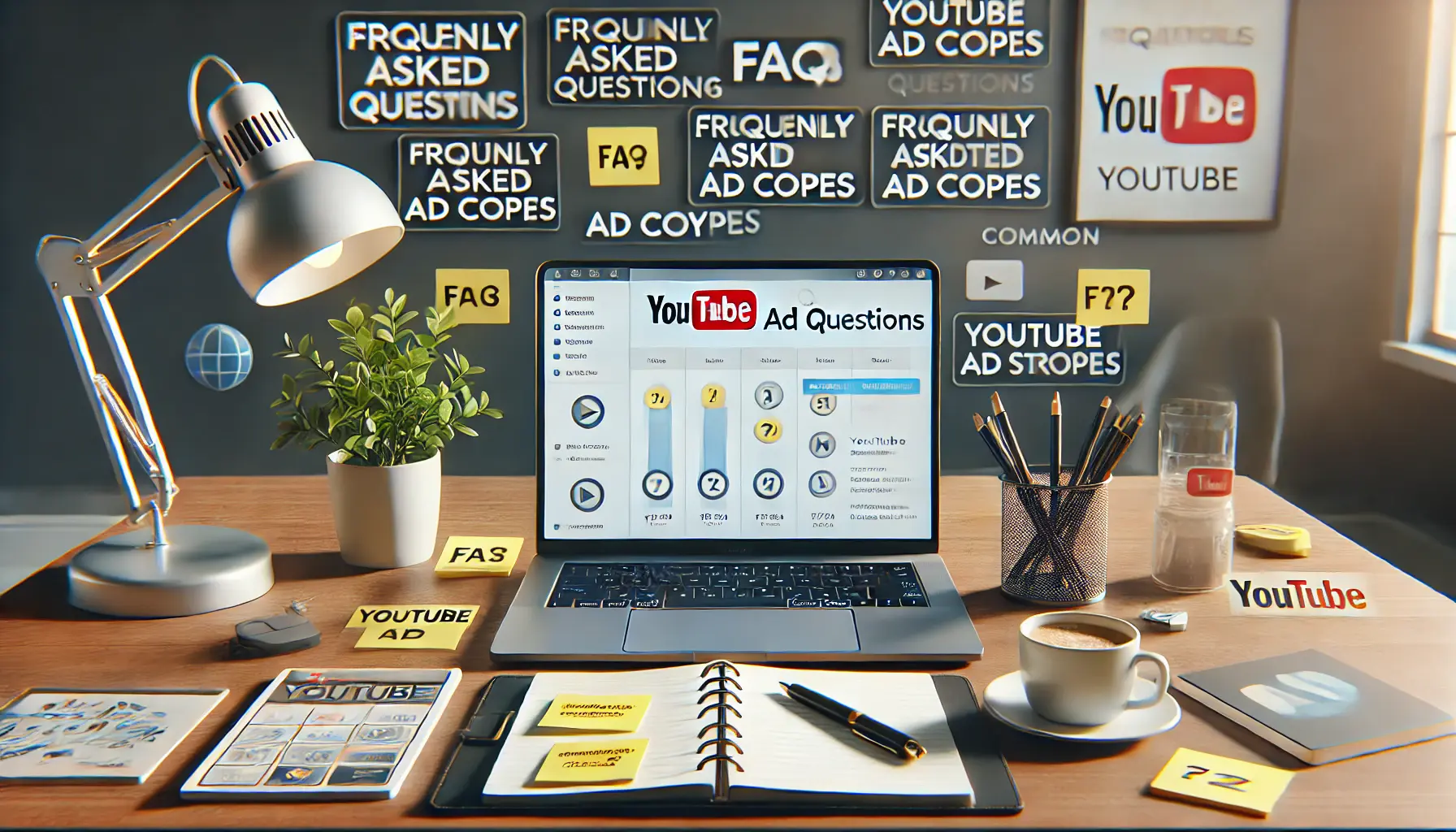
Workspace focused on frequently asked questions about YouTube ad copywriting.
Your campaigns can be managed by an agency specialized in Google Ads, check out our service page.
FAQs on Writing YouTube Ad Copies
Below are some of the most frequently asked questions regarding the optimization of YouTube ad copy to improve engagement and conversion.
Understanding these questions highlights the vital concepts and strategies creators need for building effective YouTube ads.
The best YouTube ad copy is clear, concise, and targeted.
It needs to captivate viewers, communicate benefits, and prompt further action.
The copy should also be tailored to the specific ad format for maximum impact and attention.
Attention-grabbing headlines appeal to viewers’ needs or spark curiosity.
Using strong verbs, power words, and emotionally appealing phrases makes headlines more compelling, encouraging viewers to watch the ad and learn more.
Keywords enhance your ad’s discoverability, making it more likely to appear in relevant searches.
Naturally placing keywords within headlines, descriptions, and CTAs helps your ad reach its target audience effectively, boosting engagement rates.
A/B testing is essential for ad copy optimization.
It allows you to test different variations to see which resonates best with your audience, facilitating continuous improvement in engagement, click-through, and conversion rates.
Measure CTRClick-through rate; a metric that measures the percentage of viewers who clicked on an ad or link., view durationThe amount of time viewers spend watching a video ad., and conversion rate to assess ad copy effectiveness.
These metrics indicate how well the copy engages viewers and drives them to take desired actions, like visiting a website.
Effective CTAs are clear, actionable, and relevant to the ad’s purpose.
Phrases like “Learn More” or “Shop Now” encourage action while reinforcing the ad’s message and enhancing viewer engagement.
Yes, tailoring ad copy for each format—whether skippable, non-skippable, bumper, or in-feed—ensures it performs well within the format, maximizing viewer engagement and conveying the message effectively.
Common mistakes include overly complex language, vague CTAs, and not considering the viewer’s perspective.
Keeping the copy simple, engaging, and relevant helps avoid these pitfalls.
Regularly review ad performance to identify areas for improvement.
Refreshing ad copy periodically, especially as viewer preferences or industry trends change, keeps content fresh, relevant, and effective.
